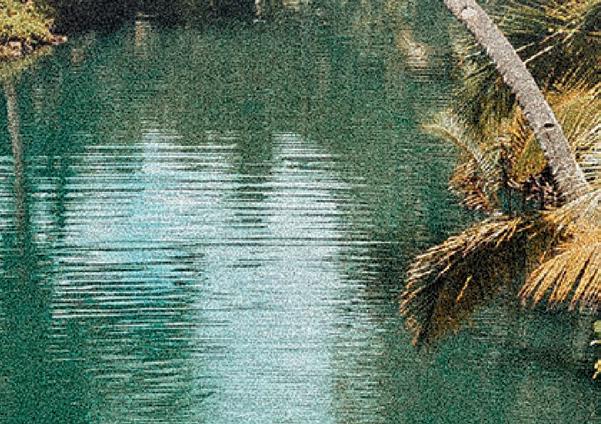50% travel, 50% charity, 100% meaningful
50% travel, 50% charity, 100% meaningful
16

50% travel, 50% charity, 100% meaningful
50% travel, 50% charity, 100% meaningful
16
From cruising through the countryside to tackling challenging climbs, cycling holidays are in gear
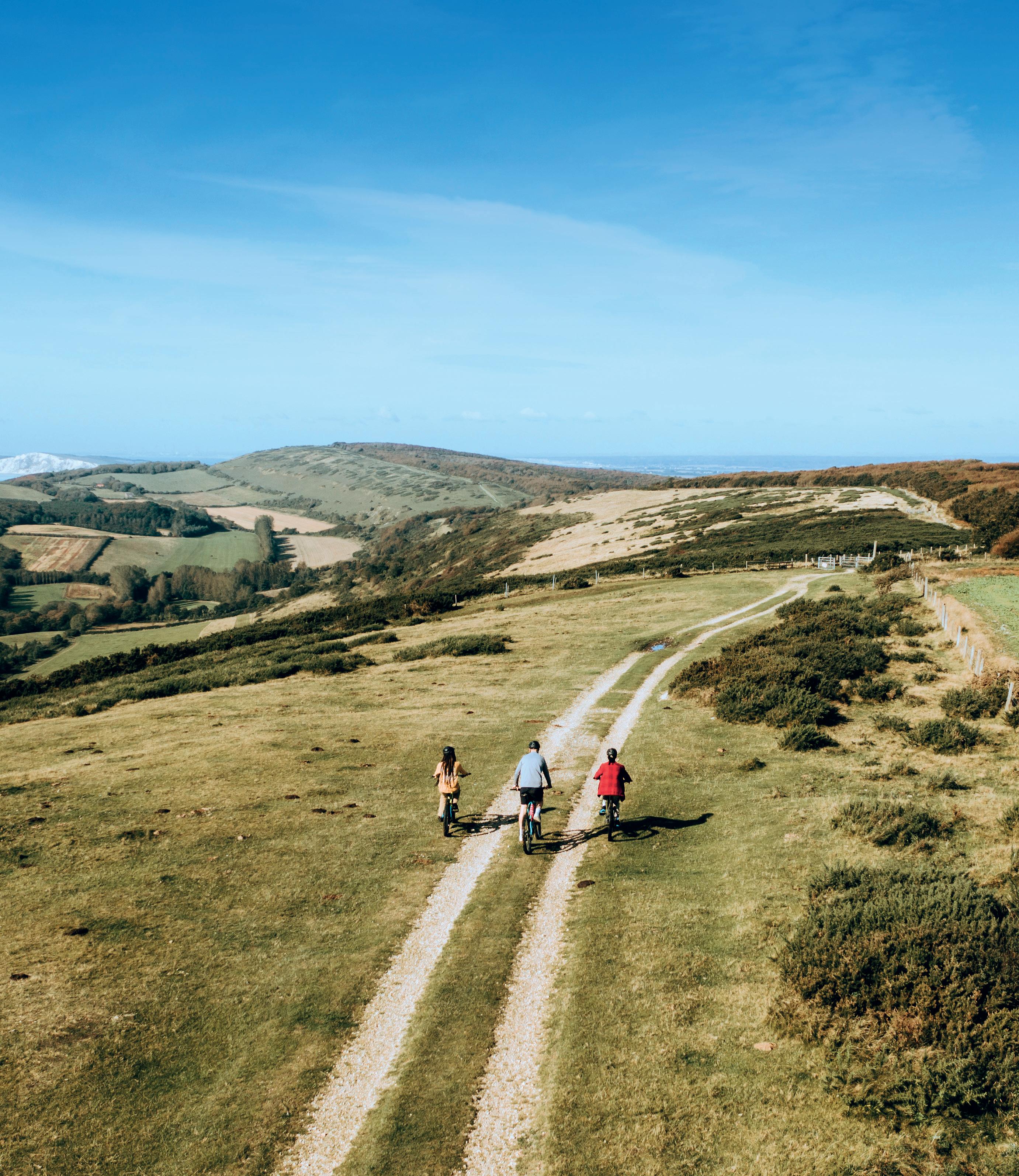

As editor of this sustainability minded magazine, it probably comes as no surprise that I’m a big fan of cycling. Both simply as a means of transport and as an activity in its own right, exploring on two wheels is one of life’s greatest pleasures and I urge you – if you can – to get in the saddle. For inspiration on where to pedal, our cover image is from the Isle of Wight, or head to p20 for ideas further afield.
Elsewhere in this issue we’re turning our attention to community tourism initiatives around the world. It’s an aspect of tourism that resonates with all the Charitable Travel team, and our writers share
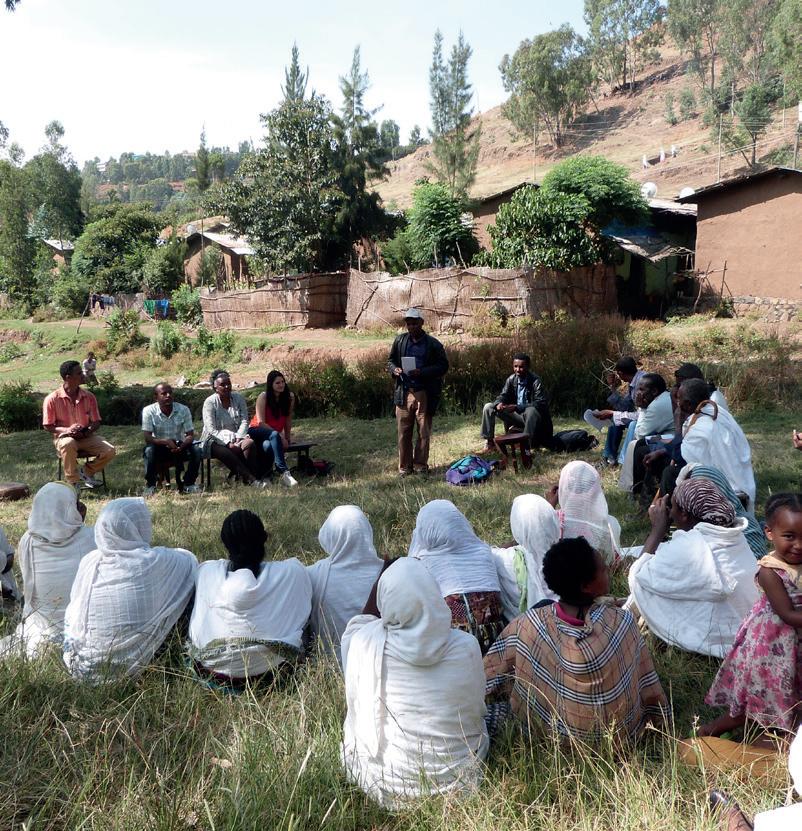

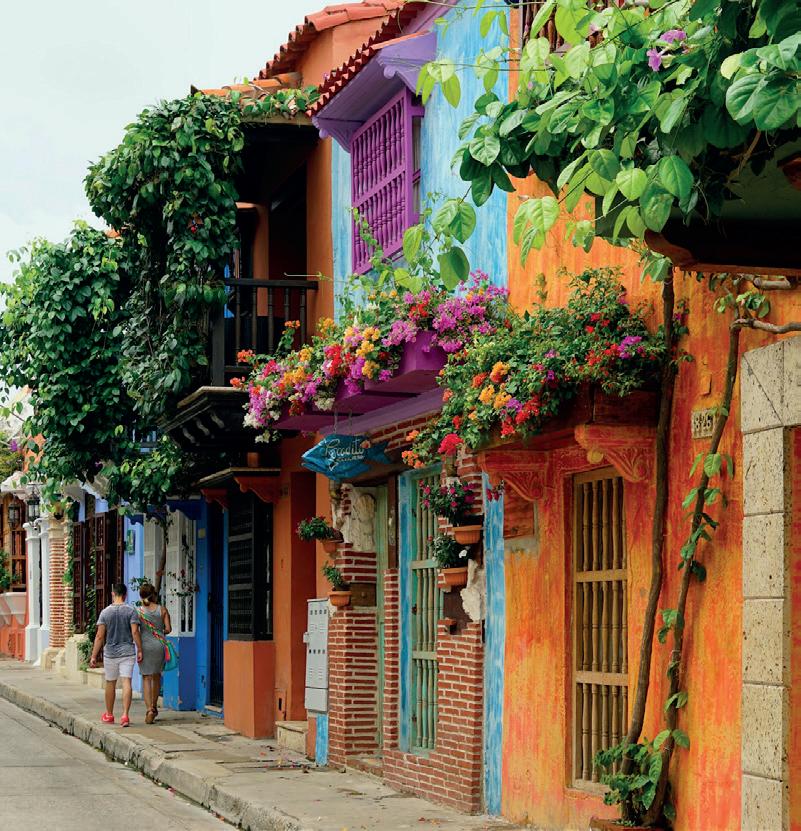
some groundbreaking projects that are having both a positive impact, and providing the most authentic of experiences for travellers who choose to visit.

It’s the people that make community tourism such a force for good, and the same can be said for the charities that we’re proud to partner with closer to home. It’s always interesting interviewing the people working on the frontline or devoting their efforts to fundraising, and I love sharing their stories in our Why I Donate, Day in the Life and Social Enterprise Q&A regular features. If you know of story we should be telling, please get in touch – my email is below.
©CHARITABLE TRAVEL 2023. CHARITABLE TRAVELLER is part of CHARITABLE TRAVEL, Fundraising Futures Community Interest Company, Contingent Works, Broadway Buildings, Elmfield Road, Bromley, BR1 1LW, UK. Putting our profit to work supporting the work of charitable causes. T: 020 3092 1288 E: bookings@charitable.travel W: charitable.travel


While every effort is made to ensure accuracy, CHARITABLE TRAVEL cannot be held responsible for any errors or omissions. FRONT COVER: Visit Isle of Wight. ICONS: thenounproject.com & flaticon.com. CEO: Melissa Tilling; MARKETING: Ally Ware, Rosie Buddell, Adam Pedley & Maddy Foot; SALES: Ali Nicholls; MAGAZINE EDITOR: Rebecca Miles (editor@charitable.travel); MAGAZINE DESIGNER: Claire Gates (designer@charitable.travel)

It’s always interesting interviewing the people working on the frontline or devoting their efforts to fundraising, and I love sharing their stories in our regular charity features



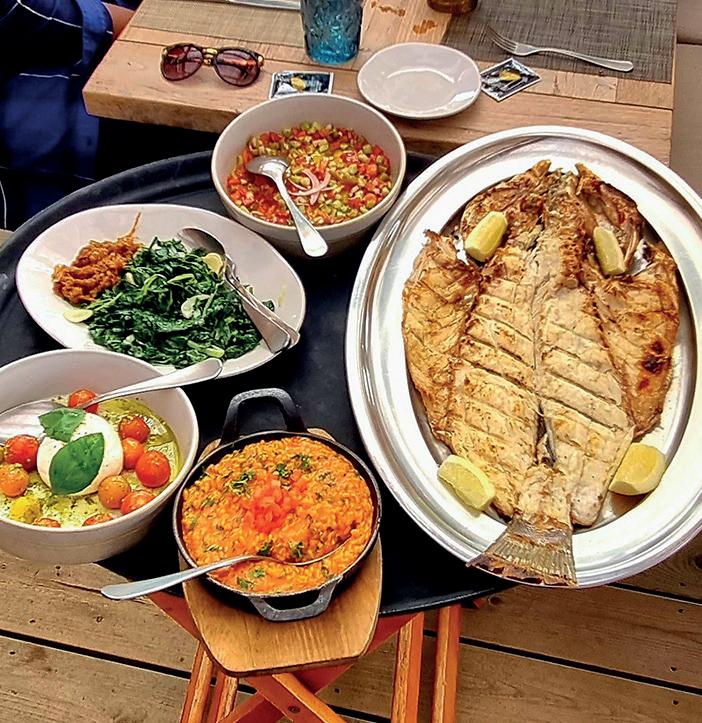

The tiny Mediterranean island has been recognised as the best place in Europe for LGBTIQ+, and will be hosting this year’s huge EuroPride event. For 10 days in September, from 7-17, it’ll be a non-stop party, with Pride Marches in Valletta and Gozo, concerts and theme parties all taking place. The Maltese LGBTIQ+ community is aware that neighbouring communities in North Africa and the Middle East still struggle with LGBTIQ+ human rights issues, and is committed to achieving full equality not just in Malta but in its surrounding communities too. Book your place now, everyone’s invited. charitable.travel/malta
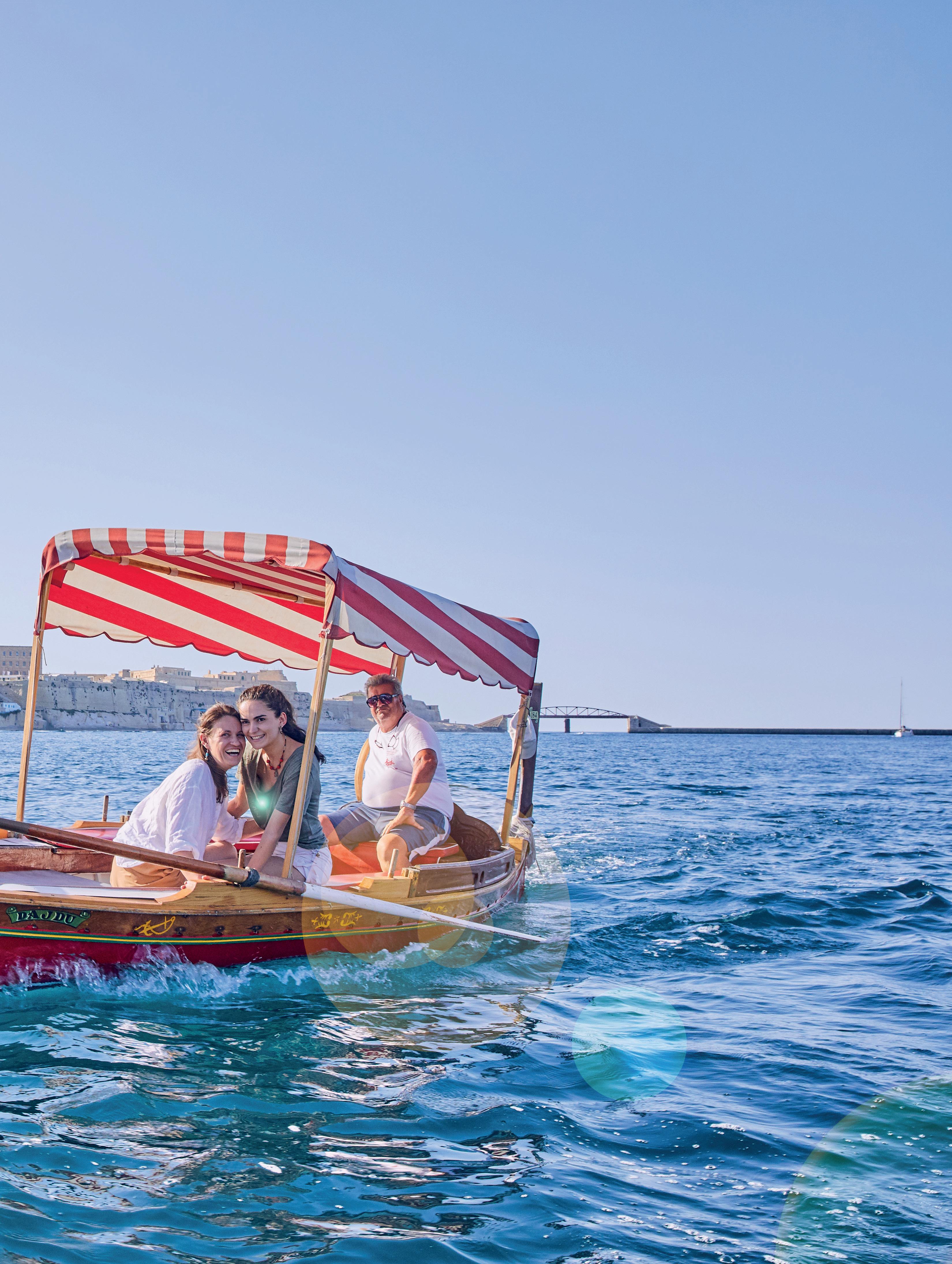



The River Vjosa in Albania has been named Europe’s first Wild River National Park. A decade in the making, the decision to protect this natural wonder has been welcomed by both environmental experts and tourism activists, as the river is home to more than 1,100 species, including many endemic fish of the Balkans. With its lush surroundings, the Vjosa is ideal for adventure enthusiasts too.

MORE THAN ONE BILLION PEOPLE IN 190 COUNTRIES CELEBRATED EARTH DAY ON 22 APRIL WITH PARADES, DIE-INS AND TALKS, URGING POLITICIANS TO ‘INVEST IN OUR PLANET’
GREECE’S WHEELCHAIRFRIENDLY BEACHES
Greece is making over 250 of its beaches wheelchair-friendly by installing the Seatrac system, a chair that moves down a track on the beach into the sea. A free service, people with disabilities or limited mobility choose the beach they want to visit from the list on Seatrac’s website, request access to the remote control then independently use the system. Greece has nearly doubled the amount of beaches with a Seatrac from last year, and is introducing other essentials, such as bathroom/ changing facilities and ramps.
NEW TREASURES FOUND IN THE GALAPAGOS
Scientists have discovered pristine, extensive and ancient deepsea coral reefs in the Galápagos Marine Reserve that are ‘teeming with life’. They’re the first of their kind to be found within the reserve since it was established in 1998. At a depth of between 400 and 600m, the reefs support a staggering mix of deep marine life, including octopus, lobsters, sharks and rays. The reefs were discovered by Dr Michelle Taylor (University of Essex) and Dr Stuart Banks (Charles Darwin Foundation, Ecuador) while diving in a deepocean research submersible, and stretch for several kilometres.
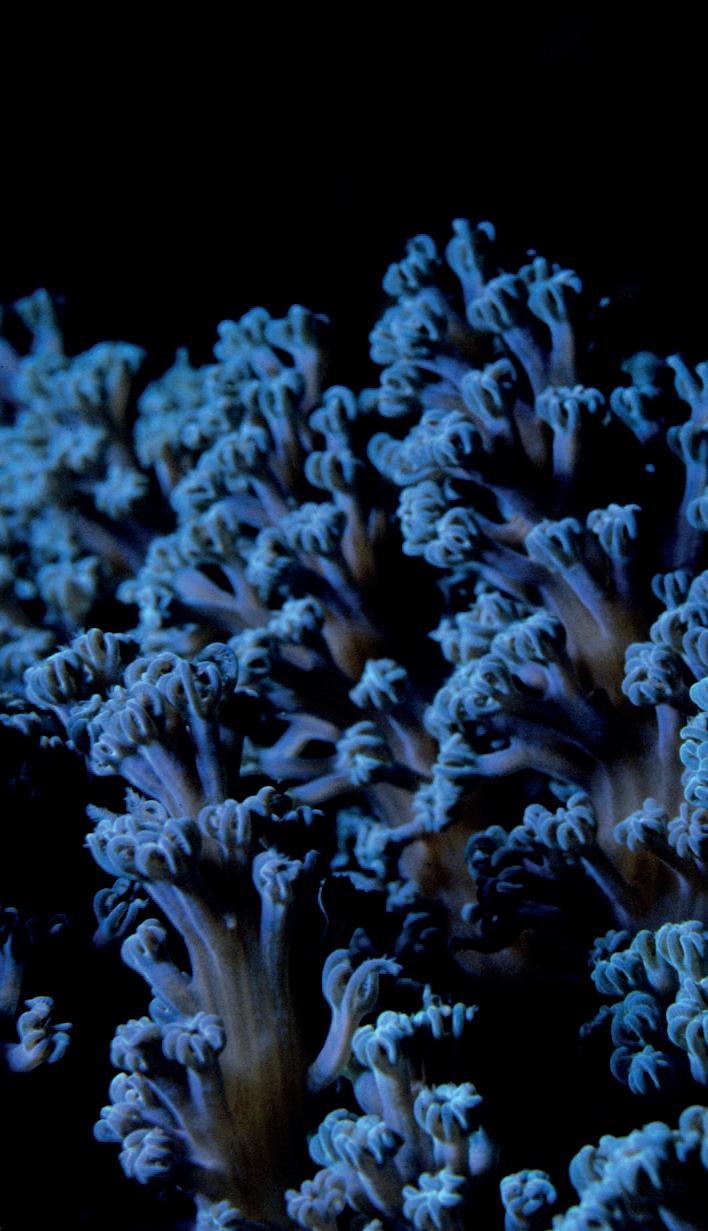
Carnival prep has started and the Caribbean island is gearing up to host its 10-day celebrations to mark the end of slavery. Expect parades, pageantry and more, starting from 1 August.
In a rare piece of good news for Britain’s beleaguered waterways, salmon and other wildlife are returning to Swindale Beck in Haweswater, Cumbria. In the 1800s, the river was straightened to make way for farms, which sped up the water and prevented salmon from laying eggs. But a project launched in 2016 by the RSPB, Natural England and the Environment Agency to ‘rewiggle’ Swindale Beck is working. The river now meanders and is 180 metres longer; the latest survey shows salmon fish have returned.

Dive into summer on the South Shore of Lake Tahoe. Catch some fish, catch some rays, and then catch a live concert. Raise your elevation hiking the Tahoe Rim Trail or ziplining, and then raise a glass at a local tavern. It’s all sorts of awesome. It’s Awe and then Some.
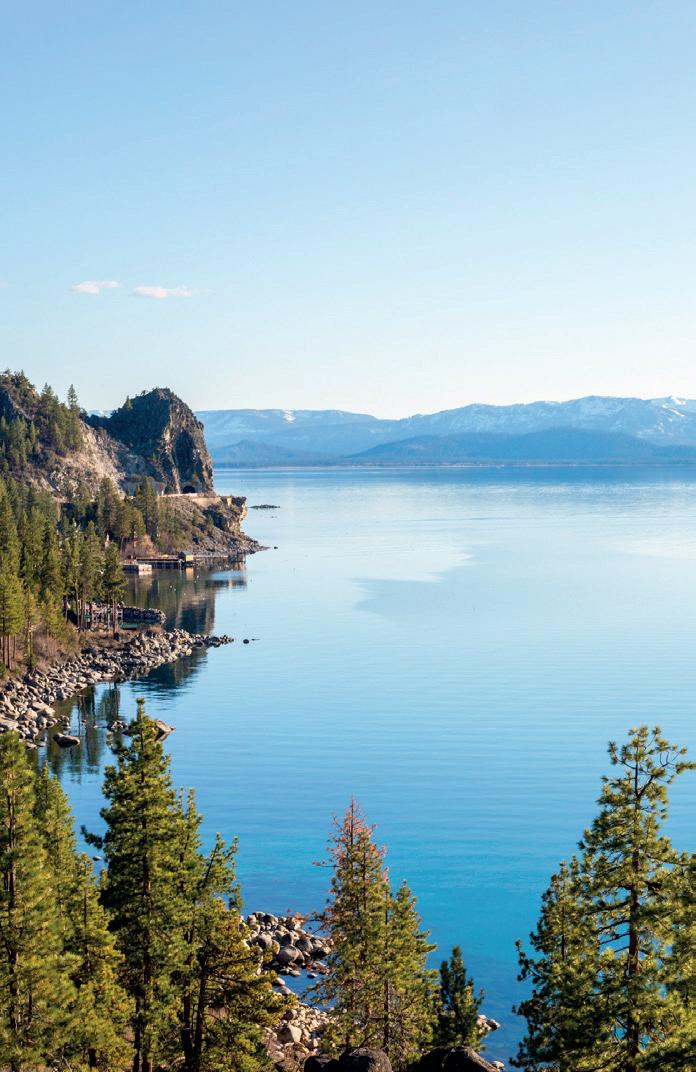
Learn more at

An award-winning architect’s practice in Bangladesh has created flat-pack homes designed for the country’s low-lying river deltas. Where annual monsoons and tidal swells leave millions of people vulnerable to flooding, these two-story ‘tiny home’, called Khudi Bari in Bengali, are light and portable, yet strong enough to withstand heavy wind and rain. Marina Tabassum, the founder of the eponymous practice, designed them to be modular. Made from bamboo, they have a pitched roof over a platform that stands on spindly legs and can be easily moved to a new location when the delta’s every changing sand beds start to vanish. Bangladesh, and in particular the coastal areas, is one of the world’s most vulnerable countries to climate change and the river delta map changes every few years, as riverbank erosion causes islands to rise and fall with the seasons.
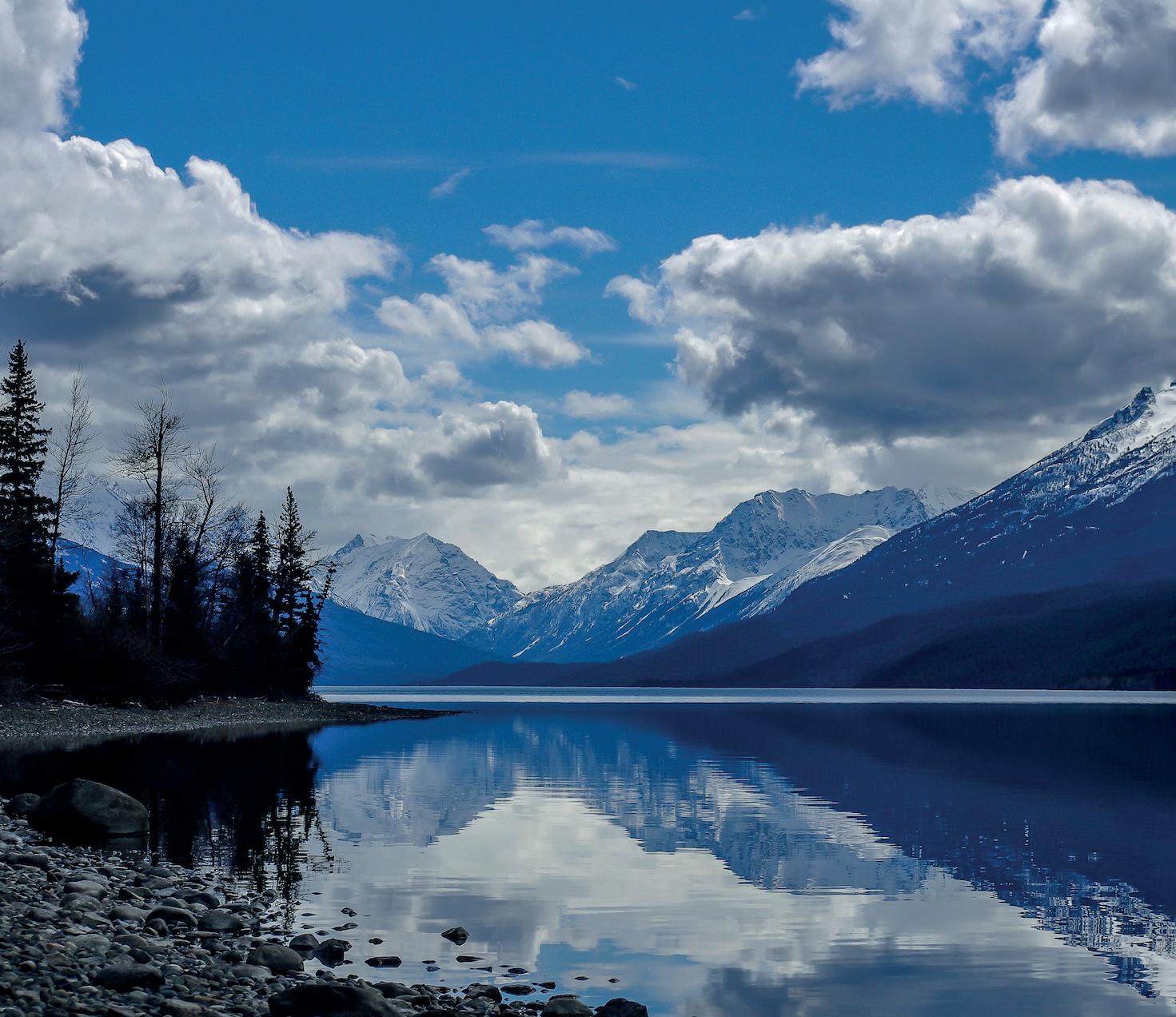
Good things come in threes, and that’s the case with recent preservation news from around the world. Ecuador, already with 11 national parks and 25 reserves, has a new one in the Morona Santiago province in the east of the country, protecting over three million acres of forests. Created by the government to recognise indigenous rights on the land, it’ll help protect against mining and livestock threats. In the Cariboo region of British Columbia, Canada, the Simpcw First Nation declared the Raush River watershed – part of the province’s vanishing temperate rainforest endangered from decades of logging – an Indigenous Protected and Conserved Area, while in Columbia, the Sierra Nevada de Santa Marta National Park has been expanded by 426,154 acres.
AMSTERDAM HAS SCALED UP ITS ‘SMART’ BLUE-GREEN ROOF PROJECT –COMBINING ROOF-WATER COLLECTION SYSTEMS (BLUE) WITH MEADOWS AND VEG PATCHES (GREEN) – AFTER STUDIES SHOW THEY REDUCE URBAN FLOODING AND LOWER TEMPERATURES.
Ghana and Nigeria are the first countries to approve a new malaria vaccine, R21, that’s been hailed as ‘world-changing’. With an efficacy of as much as 80%, it’s been approved for use in children as young as five months, and acts against P. falciparum, the deadliest of the malaria parasites.
Join Lonely Planet on a journey to 150 of the world’s most amazing islands with its latest release, The Islands Book
Lonely Planet’s The Islands Book is your passport to the most intoxicating selection of isles, atolls and keys to explore. From remote, storm-battered Faroes to tropical oases peeking out above the ocean, there’s something magical about droplets of land surrounded by water and this is the ultimate guide for globetrotters wanting to unearth new discoveries.
Presenting 150 of the world’s most unique and enchanting havens, each chosen for its rich history of secret stories, natural wonders or cultural heritage, The Islands Book includes profiles featuring an introduction from a Lonely Planet expert, a large detailed map that highlights points of interest and beautiful photography chosen to beckon paradise-hunters.
Will you be tempted most by the coral reefs of the Raja Ampat islands, the unforgettable food scene of Penang, Madeira’s gardens, the musical flair of Jamaica, the architecture of Sicily or the art of Naoshima?
The Islands Book will introduce you to the divers of Jejudo, the artisans of Islas San Blas and the conservationists of New Zealand’s Codfish Island, as well as the birds of Lord Howe Island, the wolves of Isle Royale and Komodo’s scaly dragons.

Lonely Planet’s The Islands Book is out now in hardback for £29.99, available where all good books are sold.
Win!

We’ve got 10 copies of The Islands Book to give away – to be in with a chance of winning one, visit travel/lonely-planetcharitable. to enter our competition







 By Jack Chesher
By Jack Chesher
Let the man behind the successful Living London History blog guide you through some of the city’s best hidden secrets, untold stories and special places in this beautifully illustrated hardback book with detailed maps to follow in each corner of the capital. While London may be full of museums, Jack believes the greatest museum is the city itself, with each street name telling a tale and its rivers, parks, buildings and gardens each having so much to reveal.

Netflix turns its attention to Vietnam in the newly released A Tourist’s Guide to Love. Following a young woman’s journey of self-discovery having recently come out of a long-term relationship, A Tourist’s Guide to Love follows Amanda (Rachel Leigh Cook) as she flips her life on its head and takes an undercover mission into Vietnam’s tourist industry. Filmed on location, the cities of Hanoi, Ho Chi Minh and Hoi An all star, as well as the coastal city of Da Nang, with its sandy beaches, and the province of Ha Giang along the Lo River in the north of Vietnam. Scott Ly also stars, and it’s directed by Steven Tsuchida.
WALKING WITH NOMADS: ONE WOMAN’S ADVENTURES THROUGH A HIDDEN WORLD FROM THE SAHARA TO THE ATLAS MOUNTAINS
 By Alice Morrison
By Alice Morrison
This month, we’ve got hidden tales from the capital, nomadic adventures in Morocco, a love letter to Vietnam and the spotlight on Guernsey

Scottish explorer and TV presenter Alice Morrison takes the reader on three remarkable journeys across Morocco, accompanied only by three Amazigh Muslim men and their camels. Along the way, she finds dinosaur footprints and a lost city, and avoids landmines, quicksand and the deadly horned viper. As she writes, it’s clear that few places better illustrate the reality of climate change than the desert.
A psychological thriller recently released on streaming services in the UK, Marooned Awakening was filmed exclusively in Guernsey, and pays stunning homage to the island’s beauty. Telling the story of an aspiring young journalist keen to leave his island home for a better life in the city who embarks on one final investigation before he leaves, it stars Tilly Keeper, Tim McInnerny and Murray McArthur. Expect to see such island landmarks as Portelet Harbour, Perelle Bay, Fort Hommet, Fermain Valley and St Peter Port.
—Charitable Travel
Go beyond world-famous theme parks on your next visit to Orlando — way beyond. Explore the destination’s great outdoors with lush ecosystems, ecotours, natural springs, nature trails, fishing, kayaking, airboat rides and lots of thrills. Whether peacefully paddling through spring-fed lakes or hang-gliding 600 meters above orange groves, unforgettable eco adventures serve as the perfect counterbalance to Orlando’s signature theme park fun.






Involves a mix of discussing the progress of projects with our team in Ethiopia, researching best practices for our projects, and fundraising. I’m director of Together We Learn, a small charity based in the UK and Ethiopia that works to brighten the prospects of children in Ethiopia and we focus on improving access to quality education.
We support children in Ethiopia to strive for a brighter future through access to quality education. Join us our inaugural small-group tour to Ethiopia: charitable.travel/together-we-learn
One of the main things I’m working on at the moment is our Future Girls project, where we’re facilitating discussions in schools with male and female students to try and create female-friendly school environments. It’s currently in pilot mode so I’m checking to see how the students are responding to the resources we have so far – I’ll speak to the project manager and team members to get their feedback then add in best practice that we’ve seen in other projects.
We’ve been running girls’ educational programmes in various forms for six years and it’s definitely a personal passion for me and Elsa, our country director in Ethiopia. Our current project is a progression from a partnership we ran with Days for Girls International, providing reusable period packs for school girls, and our sponsorship of about 350-400 children who are at risk of dropping out of school due to poverty. We know through our previous work that there are a lot of issues around early pregnancy, which is affecting gender parity in school the higher up you go in secondary education.
What we see from our sponsorship programme is that the girls are just exhausted. They’re responsible for the household chores and boys have a lot more freedom, partly because they don’t have to do those chores and partly because there are fewer fears about their safety.
With the Future Girls project I really want to get boys involved in the discussion of the issues affecting girls in school to build empathy and understanding, and to shift their mindset – which we’re starting to see, slowly. For example, one of the boys said he hadn’t previously noticed how much his sister did around the house. At the end of a meal, he’d hand his plate to her and leave. Now, he clears up with her, so they’re both free afterwards. It’s a small but significant shift.
This takes up a lot of my time, but I also make sure to check in regularly with our frontline teams in Ethiopia. They
deliver teaching training, carry out site visits to the schools where we’ve got construction projects running, and run the workshops that we do with girls’ clubs at schools.

I also keep up to date on the latest research – we’re a part of a few networks focussed on education in Sub-Saharan Africa so there’s lots to learn and share from them. Plus I spend a lot of time applying for grants, as well as more practical fundraising such as picking up the phone and speaking to potential donors.

Most recently, a large part of my role has been firstly planning and now promoting the small-group tour we’re launching to Ethiopia. I visited the country extensively back in September, and worked with local guides to put the initial plan together. We’ve since had a few of our long-term volunteers try the suggested tour, and I’m working through their feedback to improve it and tighten the logistics so that, for example, we’re in the right place at the right time to see the sunset.
Is securing funding. I have to find a balance between where we and our community see the need, with what people are giving away money for, and they don’t always match up.

Is the kids we help. As part of working for a small organisation, I’m closely connected to everything we do and all the updates are a regular reminder of why we’re doing it.

Once I’d decided to do the Marathon des Sables it took me a whole week to press the button to commit. I’ve run marathons, I’ve even ticked the box for the times I wanted to achieve, and I’ve completed an Ironman, so what else is there to do but this crazy race through the desert?
I like to go big or go home – before I ran the marathon I’d never run a 5k or 10k – and it doesn’t get any bigger than the Marathon des Sables. It’s the toughest foot race on earth and I’ll run approximately six marathons over the course of seven days, in the heat of the Sahara Desert. But not only does it involve basically running a marathon a day (and day four is a double marathon), it’s a self-sufficient race so I have to carry all my food, provisions and sleeping bag. The organisers provide water, but it’s rationed, and only available at the checkpoints, and isn’t just for drinking but for washing and cooking too. I’ve got my pack down to about 12kg; the elite runners will have theirs down to about 6.5kg.
I’m raising money for Scope

because my goddaughter Zoe has cerebral palsy and I’ve seen firsthand the difference Scope makes to her life. She is disabled on the left side of her body, wears a calliper on her leg, and is deaf, yet turns 12 this year and cracks on with life. She performs in dance competitions where she has to feel the beat, she climbs, swims and has completed a 5k race for life – she’s phenomenal. Scope has funded a tricycle for her so she can go on family bike rides, and an iPad to help with her school work; the charity provides support on a case by case basis. Plus Scope is great at fighting for equal opportunities for disabled people.
Zoe came out on a training run with me a couple of weeks ago and texted me afterwards to ask how my legs were feeling as hers were sore. I know I’ll think back to that conversion when I’m at my lowest points in the desert and take lots of inspiration from


it because for me the pain will only be temporary, Zoe lives with it every day. By the time you read this I’ll have –hopefully! – completed the Marathon des Sables and at the time of writing am deep in the training. It’s been allconsuming and I think my family are ready for it to be over. It’s not possible to fit a 20-mile run into your lunch break so I’ve been getting up at 4am to run before work. I know how much my daughters like me to wake them up before school, so the other day when my run hadn’t gone well and I realised I wasn’t going to be back in time, I did a diversion back home, woke them up, then headed back out again!
Support Andrea and Scope here: justgiving.com/fundraising/ Andrea-Millar-MdS
I’m looking foward to the adventure but I’m also very nervous. I’ll be out of comms for a week in the desert and I just don’t want to come last.
Andrea Millar, director of sales at the Mandarin Oriental, Canouan, is shunning five-star luxury to take on the toughest foot race on earth for Scope
Book a cycling holiday for your next trip and you’ll get more than a work out. Visit a country on two wheels – whether it’s self-guided or on a tour – and you’ll see the slower side of life, spotting wildlife, scenery and beauty that too often passes us by

There’s more to Madagascar than just tropical beaches and rainforests – as spectacular as they are. On this 14-day cycling holiday you’ll pedal past everything from the surreal geysers of Analavory to the waterfalls of the Lily river, travel the red-dust roads of Ambalavaro and through gnarly rock formations towards the Horombe plateau, and take in thrilling descents through thick forests and ravine canyons. There’s also time off the saddle – including hiking the Isalo National Park that’s full of natural swimming holes and white sandy beach time at the fisherman’s village of Ifaty. Supporting communities is at the heart of much of what Exodus offers, and this trip uses local guides, and locally owned restaurants, hotels and other businesses as much as possible. Included are eight days of road cycling with a support vehicle covering on average 77km a day. Starting in Antananarivo, tour the largely quiet roads in the middle of the world’s fourth largest island, before ending on the coast.

DETAILS Cycle Madagascar is a 14-day tour through Madagascar with Exodus Travels, including B&B accommodation, tour leader, support staff and all planned activities but not flights.
Take your time seeing both Jordan’s world-class wonders and the more ordinary – but no less fascinating – side of the country on Intrepid’s nine-day cycle tour through this Middle Eastern heartland. Float in the Dead Sea, gaze in awe and wonder at the majesty of Petra, then hop in a jeep to explore the extraordinary desert scenery of Wadi Rum and its huge sandstone mountains, before spending some time with the Bedouins and sleeping under the stars in a far-flung desert camp. Experience all this and more from your saddle as you cycle up to 45km a day and are transferred between rides by exclusive support vehicle.
DETAILS Cycle Jordan: Petra & Wadi Rum is a nineday tour through Jordan with Intrepid, including both hotel and desert camp accommodation, most meals and transport but not flights.
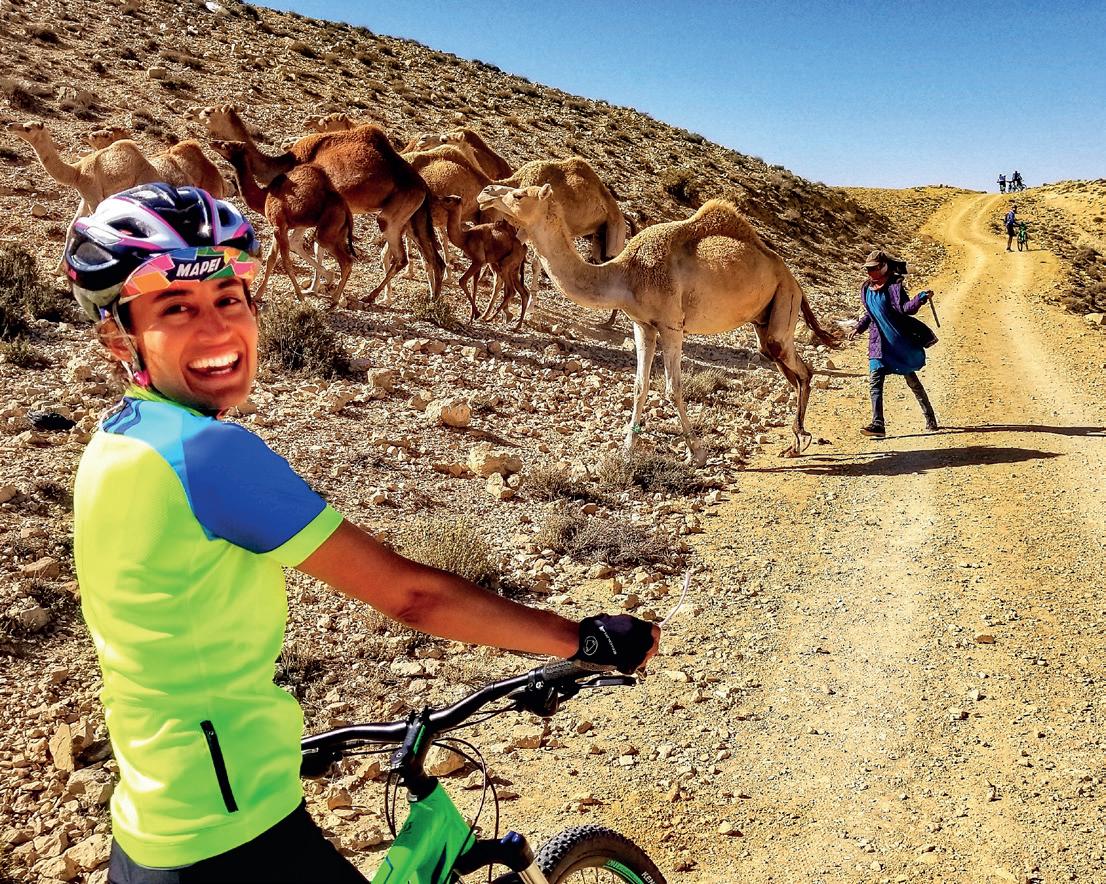
There’s something extremely satisfying about travelling from coast to coast, and that’s exactly the aim on this cycling holiday across France. Starting on the Atlantic coast at Lacanau and finishing at the Med on the beaches near Narbonne, over the course of 15 days you’ll wend your way past some of the best Bordeaux vineyards and through the most picturesque medieval villages before joining the sunspeckled towpaths on first the Garonne Canal then the Canal du Midi. Spend the nights in such historically charming towns and cities as Agen, Carcassonne and Toulouse and your days clocking up the kilometres pedalling from fresh market stall to vineyard tasting to lunch with a view. Each day expect to cover between 40 and 50km on good cycling surfaces; on two days it’s more like 70km.
DETAILS French Leave Holidays offers 15-day self-guided cycling tour, the Great Coast to Coast Crossing, including flights, B&B accommodation, luggage transfers, bike hire and detailed route guides.

Combine plenty of cycling with plenty of swimming on a cycling holiday to Lake Chiemsee, Bavaria’s largest lake. Stay close to the water in Prien am Chiemsee and venture out each day on tours around the lake, into the Alpine foothills and along crystal-clear rivers. Do as little or as much as you like, and plan in plenty of stops in typical Bavarian villages, museums, castles and monasteries too. Run by Headwater as a self-guided holiday over eight days, the suggested itinerary includes up to 65km of cycling each day – through nature reserves, past colourful meadows and among romantic hills – as well as a day spent exploring the islands of Lake Chiemsee by boat.
DETAILS Headwater offers a sevennight holiday including four-star B&B accommodation, bike hire and route directions, plus boat trips.

Thanks to the quick and easy access to great training roads and a temperate climate year-round, Girona has become something of a haven for pro cyclists from around the world. Follow in their tracks on this five-day recce and take in some of the area’s most famous climbs – Rocacorba, Els Angels, Sant Hilari and the coastal climb of Sant Grau.
Bikecation runs bespoke tours to Girona, and has a selection of bike-friendly accommodation available in the city. The norm is to spend four nights at the same hotel, heading off on different rides each day, covering up to approximately 135km and 2,300m of elevation a day.

DETAILS Bikecation offers bespoke trips, including B&B bikefriendly accommodation, evening meals, picnic lunches, return airport transfers, support vehicle and high spec bike hire.
Cycling holidays
Cyprus and Jet2 offer a great-value combination for a cycling holiday. Cyprus provides the year-round sunshine and routes of varying difficulty through the island’s towns, mountains and historic treasures, while Jet2 provides the bike-friendly hotels chosen for their cycling facilities plus 32kg of bike carriage on its flights.
Journey from east to west across the island, starting on the flat coast around Larnaca before climbing up the hills towards Paphos or the epic Troodos Mountains. If you’re after a more leisurely pace, follow the seafront in Limassol or tour the vineyards.

DETAILS Jet2 offers a range of cycle-specific holidays throughout the year that include specialist hotel accommodation, bike carriage on the flight and bike transfers to and from your hotel.
At Mayah’s Legacy, we provide


person-centred support. We help you develop the knowledge, skills and confidence needed to effectively manage and make informed decisions about your own health and care. We are collaborating with professionals to introduce a series of webinars that explore self-advocacy, self-compassion and selfawareness. We want to help you gain the confidence to communicate your needs, and we encourage you to choose the path of care and well being that works for you. We want to help you embrace hope as you move forward on the path of grief.
We also provide individual support if you need to speak to someone about your concerns We respond to the challenge you face by listening and signposting accordingly

Set yourself the ultimate running goal in 2023, and achieve it with personalised guidance from inspirational ‘Marathon Man’, Rory Coleman. Run ten kilometres a day over five unforgettable days, through the spectacular natural landscapes and beautiful cities of the Danube, totalling 50 kilometres of new discoveries, new friends and new feelings of remarkable personal achievement.

This incredible challenge is open to everyone, all you need is determination and commitment. The reward will be all yours.
OUR




you invest in this challenge, Rory will offer one-on-one guidance and tools to prepare you mentally and physically for success.
Departs 25 October 2023, 6 Night Premium All-Inclusive
£1,099

Words: Lauren Jarvis
Lying in the English Channel and just a stone’s-throw from France, Guernsey is close enough for a relaxing weekend escape, yet far enough away for a thrilling overseas adventure. With speedy connections from the UK by ferry and plane (40 minutes from London Gatwick, three hours by ferry), and easy island hopping between the archipelago’s main isle and surrounding Alderney, Sark, Lihou and Herm, there are endless opportunities to explore and whether you’re an adrenalin-seeker, history buff, nature lover, or you’re simply looking for some R&R, you’ll find plenty of unique must-dos to pop on your holiday hit list.
The pretty hub of St Peter Port – or ‘Town’ as its known by the locals – is the main gateway to Guernsey, with quaint cobbled streets, enticing restaurants, browsable boutiques and sweeping views of the archipelago and yachts sailing the English Channel. Steeped in history, the town’s 800-year-old Castle Cornet stands guard at the harbour mouth, while opulent Hauteville House, the fascinating former residence of exiled French writer, Victor Hugo, is an inspiring spot to while away an afternoon.

Guernsey’s spectacular coastline is all the reason you’ll need to get out on the water, and whatever your experience or fitness level, you’ll find an activity that will leave you with that healthy holiday glow. Try a surfing lesson with Guernsey Surf School at Vazon Bay, or join a guided kayak or stand-up paddle boarding session with Outdoor Guernsey and explore the island’s secluded bays, sea caves and wrecks. The rugged Pea Stacks islets at Jerbourg Point are ripe for a spot of coasteering, too.


And another thing...
CAR-FREE ADVENTURE
The world’s first designated Dark Sky Island, carfree Sark is just a 35-50 minute ferry ride from Guernsey, but feels like a world away. Hop on a bicycle or horsedrawn carriage to explore.
WILD ISLAND
The wonderfully wild island of Herm is just a 20-minute boat journey from St Peter Port. A nature-lover’s dream, the island’s easyto-hike coastal path leads past stunning sandy beaches, rock pools and dunes.

BIRDERS’ PARADISE
Guernsey and its islands are a magnet for bird watchers, and an hour on the ferry will take you to Alderney, known for its large colonies of puffins and gannets, and home to the Alderney Bird Observatory.
Whether wild swimming or sun lounging is your bag, Guernsey has a host of perfect beaches and bays for an idyllic island escape. A spectacular coastal walk from St Peter Port, Fermain Bay’s clear aquamarine water beckons for a refreshing dip. Or take a picnic prepared by the Guernsey Hamper Company to enjoy on the sands at Pembroke Bay. Guernsey Swim Adventures offers guided swims around the coast, while The Bathing Pools at La Vallette have four tidal pools and a cafe to replenish after taking the plunge.
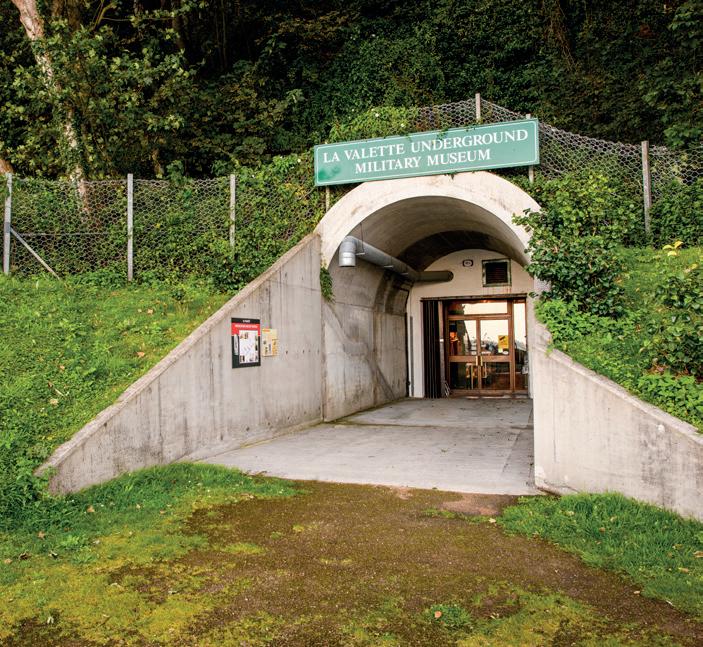
From pretty strolls around historic St Peter Port to heart-pumping hiking and biking routes, Guernsey has miles of trails to explore. Download the Visit Guernsey app which includes self-guided walking routes for all ages and fitness levels, highlighting historic and natural points of interest along the way. The annual Autumn Walking Festival offers tours with accredited expert guides, and is a great opportunity to learn more about the island’s exciting history, wildlife and culture.
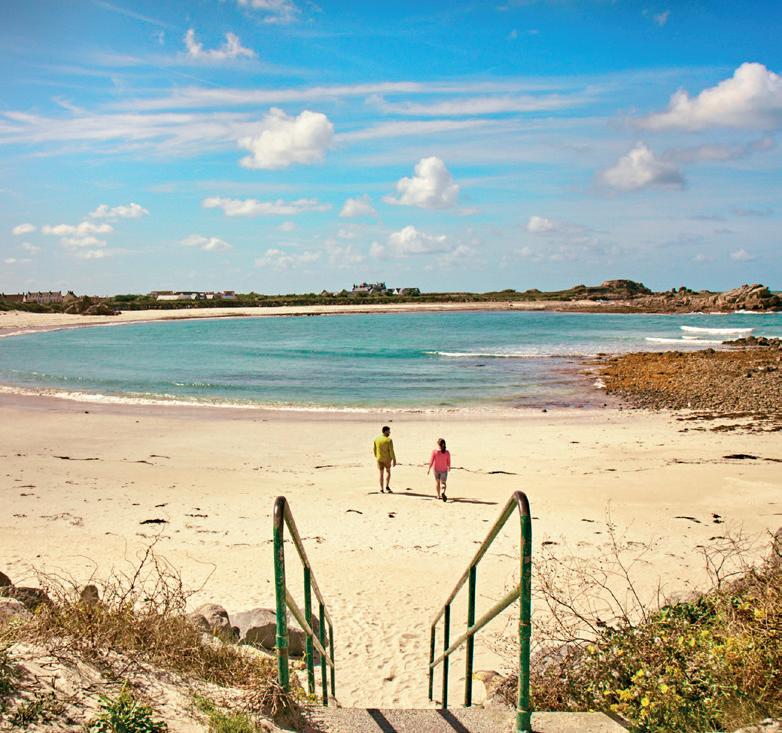
Scattered with ancient Neolithic statues, Napoleonic forts and German fortifications dating from the island’s occupation during the Second World War, Guernsey is a treasure trove of historic sites. Join an island safari in a custom-built Land Rover with Tour Guernsey to see some of the highlights, including La Gran’mère du Chimquière, a mysterious 4,000-year-old standing stone outside St Martin’s Parish Church, and The Little Chapel, an astonishing shell-decorated replica of the grotto and basilica at Lourdes in France.

The Islands of Guernsey are one of three territories in the British Isles – along with Jersey and the Isle of Man – that aren’t part of the UK, but which are selfgoverning dependencies of the Crown
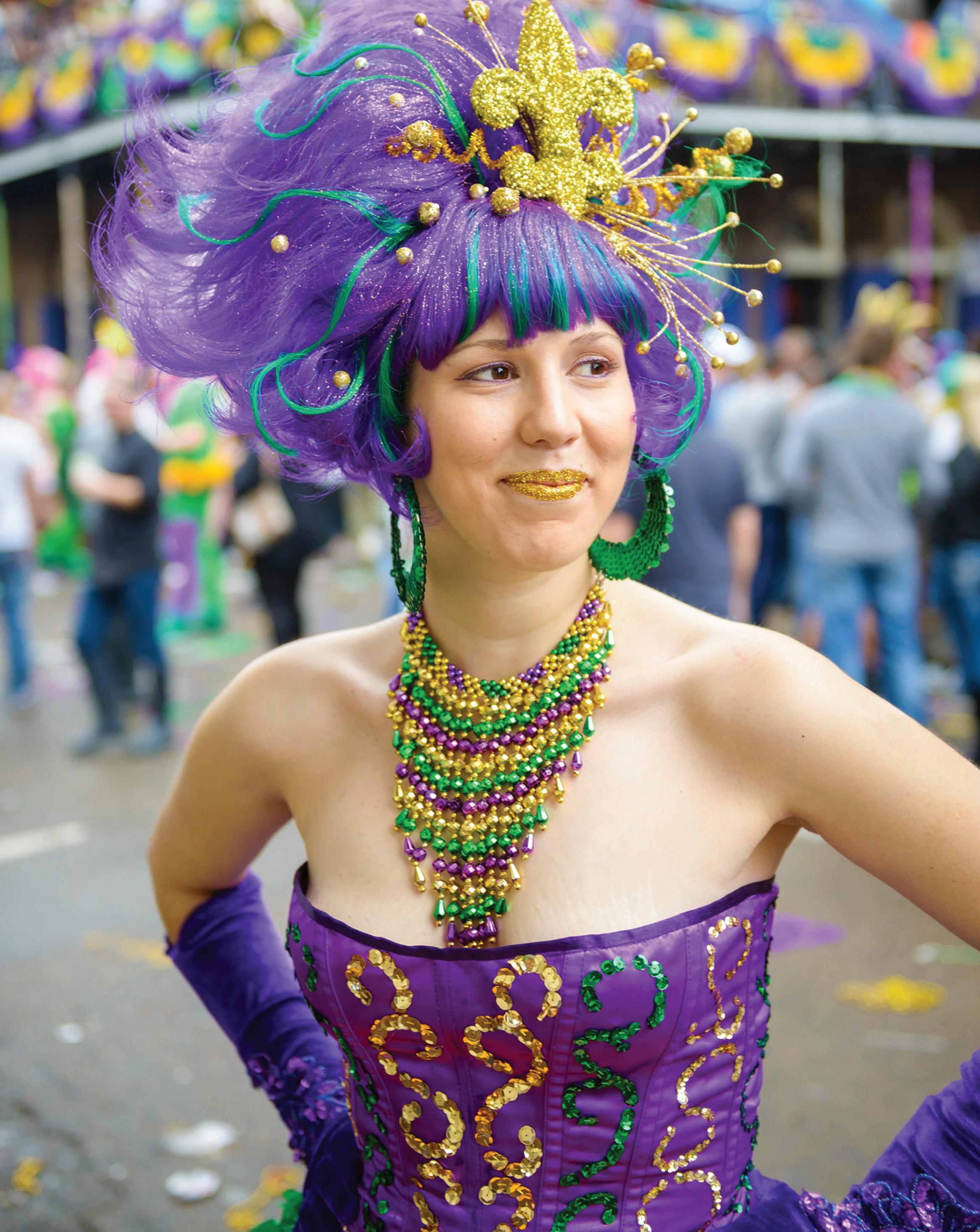

Alentejo in spring has been a delight. With balmy 20ºC days, azure skies and wispy clouds, it was the perfect time to explore the largest region of Portugal.
We started in Alentejo’s capital city, Évora. Within its original Roman walls we found a buzzing university campus but also pretty cobbled streets and a church with an exhibition of nativity scenes made by craftsmen from around the world.
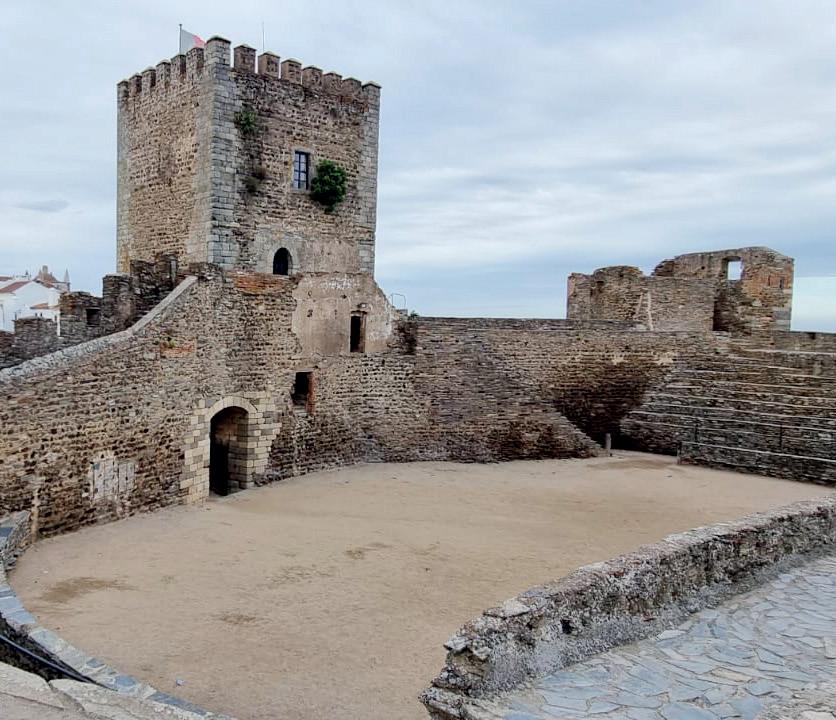
The history of the region was evident from the Moorish castles, Roman villas, temples and convents that we saw, some now converted into Pousadas and hotels, where I wished the walls could talk.
Just outside Évora, we visited Pepe Aromas, a sustainable organic enterprise built in a disused railway station with hectares of prickly pear cacti growing among its cork trees.
As we drove along the impeccably straight roads, the scenery changed so regularly and we’d frequently spy storks nesting on top of telegraph poles. We passed fields of almond, olive and pine nut trees, as well as forests of cork trees
 By Ali Nicholls
By Ali Nicholls
and glorious vineyards. At this time of year carpets of white and yellow flowers surrounded them.
While in Alentejo, we stayed at two very special vineyards, Herdade Malhadinha Nova Country House and L’And Vineyard, plus had an amazing lunch at Torres de Palma Wine Hotel.
The Portuguese were so hospitable – I met some of the most wonderful people here – and were very generous with their gastronomy. With rice production huge in this area I have gorged on every flavour of risotto, along with delicious salads served with local olive oil and rustic bread – a vegetarian delight – and of course all accompanied by the most incredible wine. To walk off some of the calories we headed to the coast. Alentejo has 100km of coastline, and is considered to be the last wild stretch of coast in Europe. We visited Comporta, both a village and also a stretch of golden sandy beach with dunes protecting the rich, ricepaddy fields behind, and had a superb lunch at the Sublime Beach Club, washed down with rose sangria. Obrigado, Alentejo!

Alentejo has the largest artificial lakeland area in Europe with coves, beaches and lakeside trails to explore
Visit in September to get involved in harvesting the grapes and the prickly pears
A delicious feast

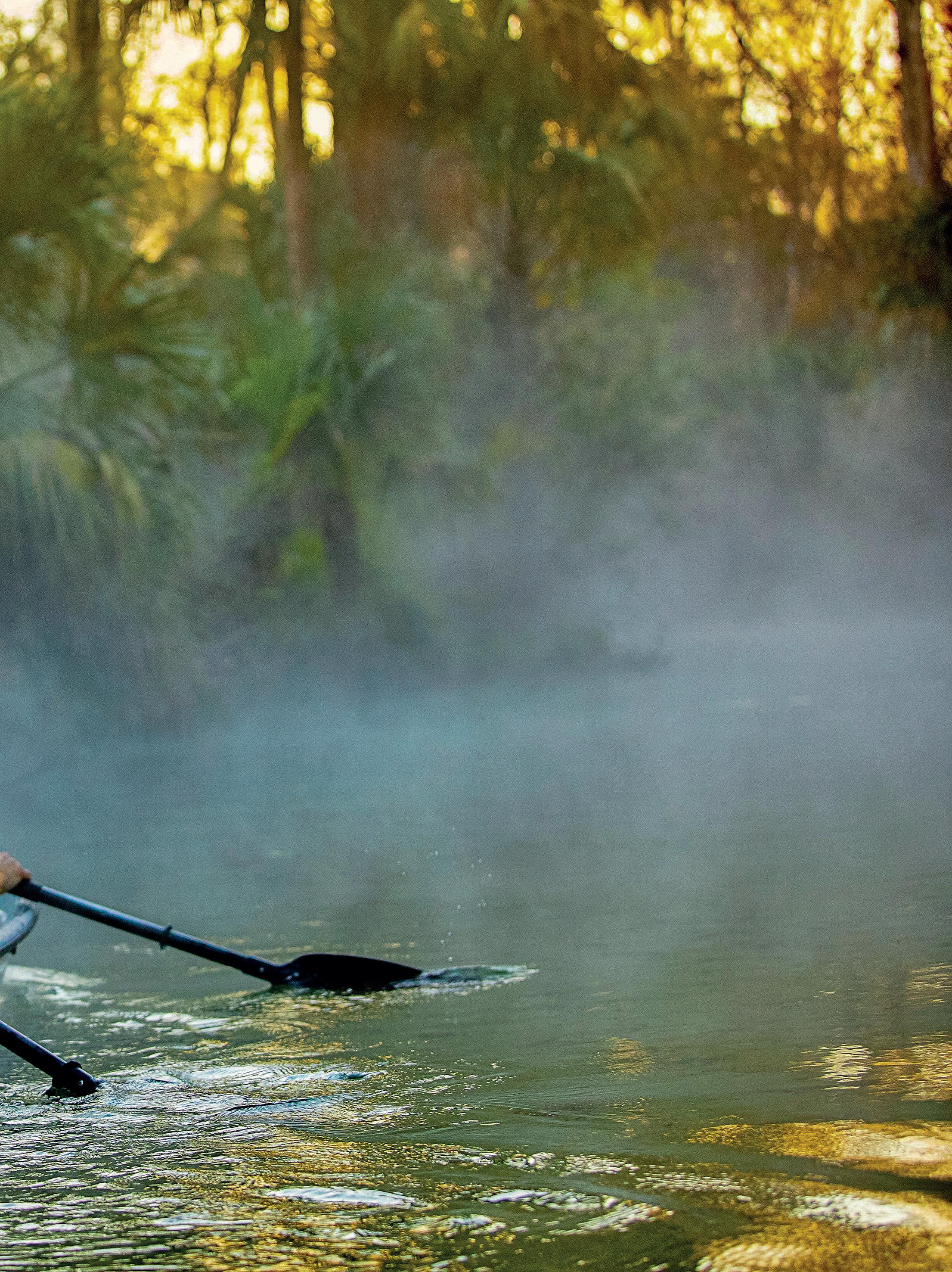
Words: Helen Wright
Cycle through an orchard of fragrant orange groves, pausing for a cold beer at a local craft brewery or navigate crystal clear waters by kayak, weaving serenely between the mangroves on a series of hidden canals, all just minutes from the world’s most incredible theme parks. Explore colourful neighbourhoods, rich in history and slurp authentic Vietnamese pho with smoked brisket sunken into the broth, skin still crispy and drizzled with chilli and lemongrass picked directly from the garden outside.
Orlando is full of surprises, but perhaps the best-kept secret of them all is shoulder season, the golden weeks of off-peak, where the pace is slowed, prices drop and the same incredible attractions, hotels and restaurants are waiting for you to explore – without the crowds. With almost 59 million visitors a year, Orlando is the number one U.S.
tourist destination and it’s easy to see why. Walt Disney World commands the most attention, dominating the theme park landscape with its centrepiece castle, world class attractions and immersive storytelling, with Universal Orlando Resort, SeaWorld and Legoland adding to the fun. But the real magic lies beyond the theme parks. Stay longer with some fantastic deals to be had by visiting off-season. Between September and November, once the summer surge has eased and before the Christmas crowd arrives, is Orlando’s sweet spot. There is so much to do, Orlando offers absolutely everything for the perfect holiday. From Michelinstarred restaurants to natural beauty spots, local attractions, splendid hotels, shopping, arts, culture and curious neighbourhoods, Orlando is a ride. Here’s a look at what’s on offer beyond the world-class theme parks, because there’s something unexpected around every corner.

Florida is beautiful. Embrace Orlando’s great outdoors, which almost hides in plain sight with an abundance of flora, fauna, beautiful landscapes and native wildlife nestled in between the attractions and entertainment. Orlando’s natural beauty serves as the perfect counterbalance to the destination’s signature theme park persona and the cooler winter and spring months are the perfect time to explore. You don’t need to go far, either, with urban stand up paddleboard and kayak tours available in the heart of Orlando and ecotours within driving distance of the tourism districts.
Orlando knows how to have fun, but white-knuckle rollercoasters aren’t the only way to get a thrill. Hold on to your hats, literally, as you zoom through tall grass and swamp in search of alligators, cranes and other native Florida wildlife on a classic airboat. Boggy Creek Airboat Adventures uses expert guides with a keen eye to spot local alligators nestled in the reedy waters, which you can marvel at from the safety of your ride.
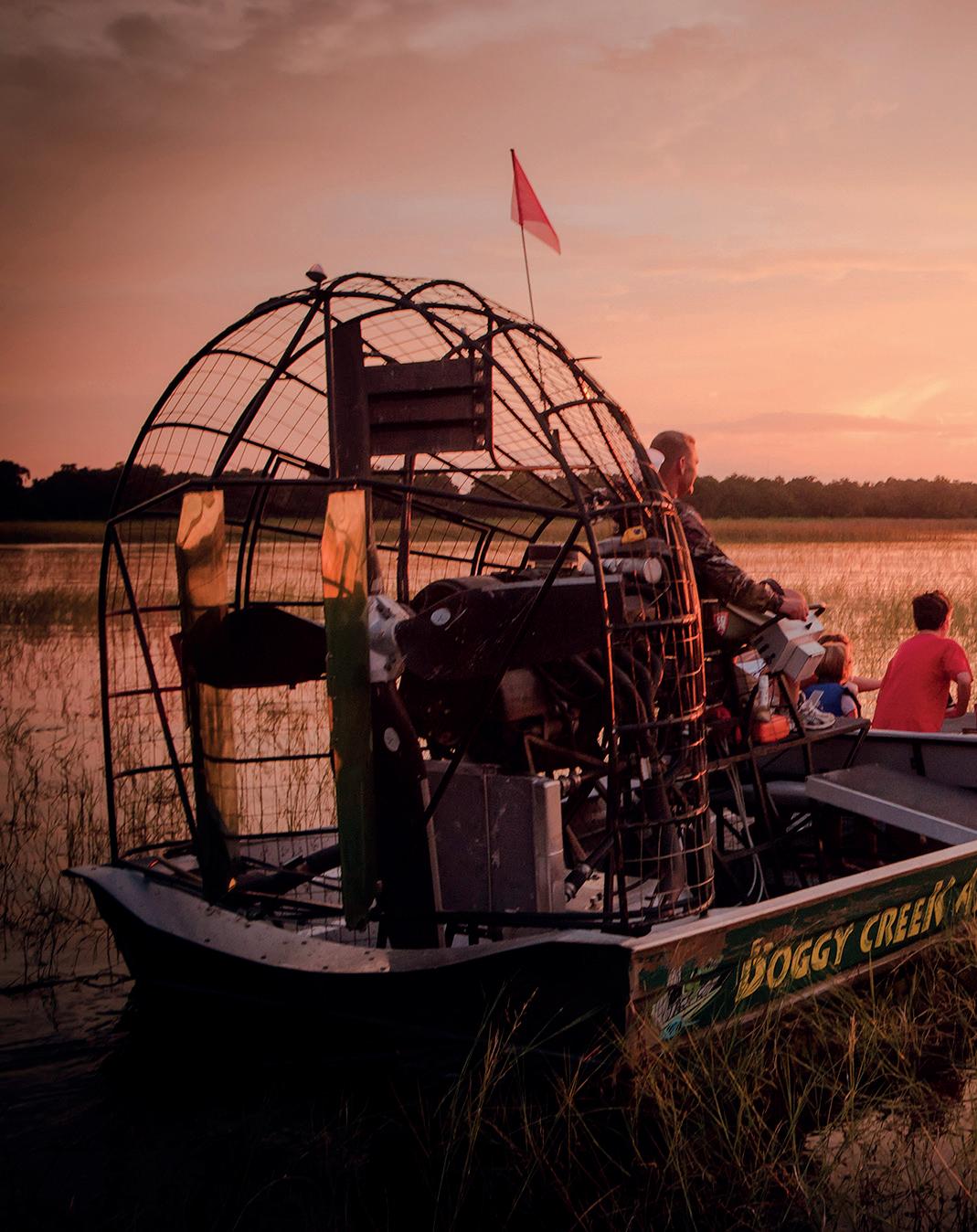
On land, explore the incredible biodiversity of Florida’s native ecosystems along the Florida National Scenic Trail, which covers 1,500 miles from the Panhandle in the northwest of the state to the Everglades in the south. In Orlando, the route takes you through pine flatwoods, freshwater marsh, oak hammock and more at Crosby Island Marsh Preserve and Moss Park. The breezier option is to hop on a bike and follow the West Orange Trail, a disused railway line that is now a cycle route, passing though woodland, beside picturesque lakes and rivers and through charming residential areas.
To get a taste of some of Orlando’s most authentic neighbourhoods, head first to the Mills 50 district, or as its affectionally known:

little Vietnam. Huge art murals, affordable restaurants and a celebration of Asian-American culture has catapulted this cool corner of Downtown Orlando into the mainstream. Start with lunch at Pho 88 then stay all afternoon, browsing the unique shops and sampling local arts and customs in one of Orlando’s most interesting and colourful communities.
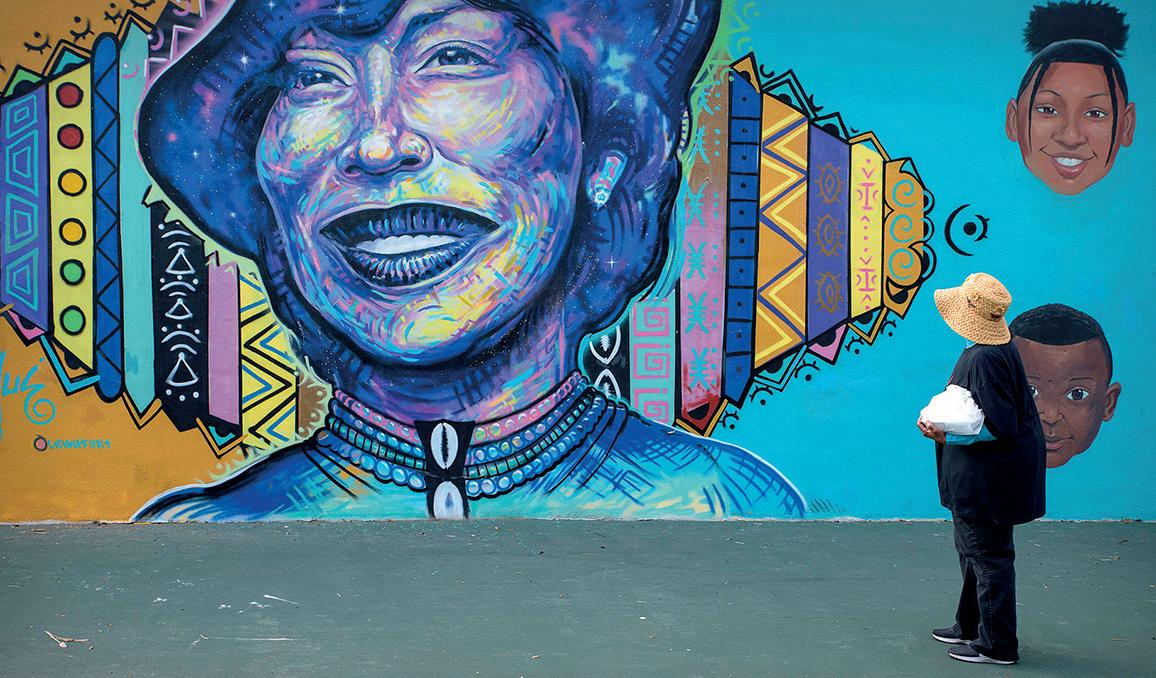
From here, head south to Milk District, best known for its T.G. Dairy Plant, which opened in 1955 and is still in operation today, in what is now one of Orlando’s trendiest towns. Don a cap and a band t-shirt and mingle with the locals alongside vibrant art murals, artisan markets and music festivals. Don’t miss Tasty Takeover – a weekly food truck block party with music, great food and a glimpse at modern Americana at its best.
The more gentrified Winter Garden also attracts the cool crowd. Plant Street Market has a boutique brewery and a lively food hall with an outdoor beer garden for soaking up that late summer sun. Or, head to the similarly named, yet very different suburb of Winter Park, a picture-postcard American town straight from a Netflix movie. The historic town oozes charm, while its well-heeled clientele browses
elegant boutiques and shops. Book a table at Prato, where the potato gnocchi with truffle butter is a triumph. Finish with a scoop of gelato – the mouth-watering flavours change every week.
There are six lakes in Winter Park, each connected through a network of canals. The Winter Park Scenic Boat Tours that cruise the waterways are one of Orlando’s oldest tourist

Orlando’s natural beauty serves as the perfect counterbalance to the destination’s signature theme park persona and the cooler winter and spring months are the perfect time to explore.
attractions – in operation since 1938 and still embracing that laid-back Florida mood.


There are more than 480 hotels and resorts in Orlando with over 130,000 rooms to choose from. The off-season months are where visitors can really take advantage of the best deals. For affordable luxury, upgrade your stay by snapping the lowest rate offers and free nights at a premium hotel, often costing the same as a midrate hotel in the high season.

For families, Orlando’s accommodation game is strong, with excellent-value options close to the theme parks. You’ll find affordable resorts in every part of town, including on-site at Walt Disney World and Universal Orlando, International Drive, the heart of downtown and in Orlando’s surrounding counties. The gloriously colourful Lake Nona Wave Hotel is reminiscent of a New York design property, with unique art and sculptures on display. At the other end of the spectrum, Margaritaville Resort Orlando comes complete with beach club energy and a splash-tastic waterpark next door. If you’d rather somewhere to wind down after action-packed days, not every resort is on such an epic scale – for example, the newly opened Daskk Orlando is a boutique hotel with chilled out vibe.
The incredible evening shows at Walt Disney World aren’t the only showcase in town, in fact Orlando’s arts scene is thriving. Start downtown, at Orlando’s Dr. Phillips Center for the Performing Arts, which has dynamic productions from international and local artists representing virtually every genre. This includes Broadway productions, chart-topping musicians, the Orlando Ballet and the Orlando Philharmonic, comedy and family entertainment.
A free way to get your culture fix is to head to CITY unseen, an augmented-reality public art
project, which includes murals coming to life, projectionmapping and a 360-degree visit to an artist’s studio, all unlockable with a free mobile app. In historic Eatonville, just 15 minutes west of Winter Park, explore the works of celebrated author Zora Neale Hurston and artists of African descent at The Hurston Museum. From there, take a stroll around the area and spot the colourful murals and poetry that decorate the streets, all created by a local art project.
The fact that Orlando’s tremendous dining scene is such a surprise to most visitors is part of its magic. What is initially perceived as a hotdog-between-rollercoasters cuisine is actually a destination with an impressive range of fantastic locally-sourced produce, Michelin Guide restaurants, celebrity chefs, gourmet food trucks, breweries and wineries. And the best part is you can eat like royalty in Orlando, no matter your budget or preference.

In this year’s second edition of the Michelin Guide Miami, Orlando and Tampa, 41 restaurants are featured. Foodies can devour the soft and creamy Porterhouse at Capa Steakhouse & Bar, indulge their senses with a rainbow chirashi bowl from Kadence or indulge in a decadent multicourse dining experience at Soseki, where food is served ‘Omakase’ – loosely translated from Japanese as ‘chef’s choice’.
In the North Quarter District, Reyes Mezcaleria features flavourful Mexican food and tequila to taste (make it budget friendly with the crispy $6 tacos during happy hour). For a more casual eatery that doesn’t compromise on flavour, book in advance for gourmet farm-totable restaurant Artisan’s Table, where the braised short rib is simply perfect. There is no doubt that Orlando’s diverse dining has character – and that’s before you’ve made it to the theme parks.
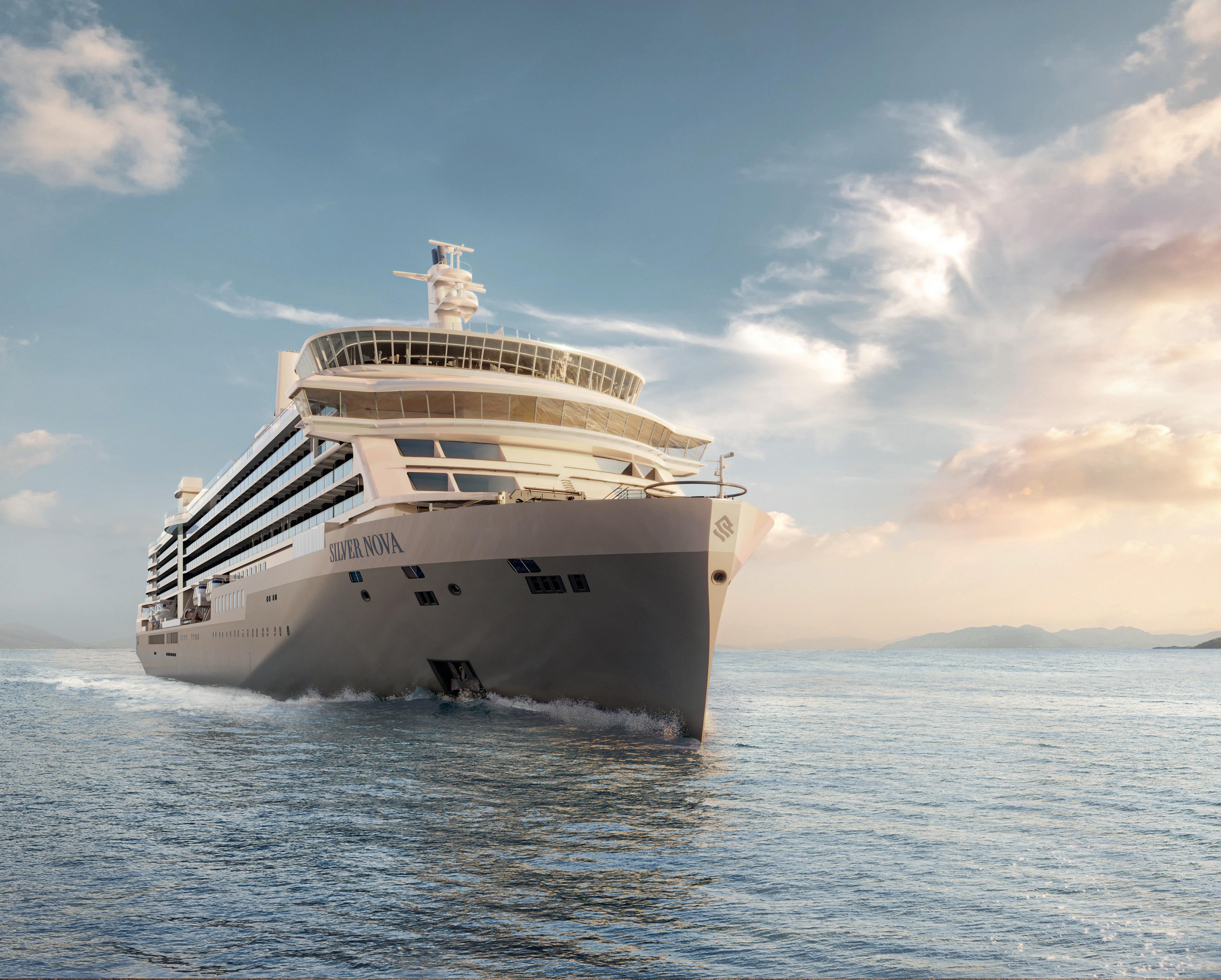
Silversea is an ultra-luxury, all-inclusive cruise line, sailing to over 900 destinations, spanning all seven continents, aboard intimate ships. Butler service; fine dining; drinks; shore excursions; onboard gratuities and WiFi are always included. Debuting in Summer 2023, Silver Nova offers an immersive destination experience to our guests and will be our most environmentally friendly; thanks to her groundbreaking technological solutions, she will propel Silversea into a new era of sustainable cruising.
• Private executive transfers (home-airport)
• Economy Class Air/Business Class upgrades at reduced rates or Air Credit
• Domestic flights when required
• Pre- & post-cruise hotel night/s when required
• Multiple restaurants, premium beverages & 24h room service
• Butler service in every suite category
• Unlimited Wi-Fi
• Onboard gratuities
CARIBBEAN
Voyage N. SN240305010
BRIDGETOWN
Departure 05 Mar 2024
Duration 10 Days
Silver Nova
DOOR-TO-DOOR FROM £6,800
Plus enjoy up to a two-category suite upgrade, $1,000 Shipboard Credit per suite and refundable 15% reduced deposit.
Offer applicable to select suite categories. Book by 31 May 2023.
The chilly temperature wasn’t enough to put me off on my first visit to the capital of Sweden, Stockholm. Set across a series of 14 islands, Gamla Stan (gamla means old; stan town) is the tiny island in the middle of it all and has one of Europe’s best-preserved Medieval centres. Beyond the city is the Stockholm archipelago, with over 30,000 islands.
I walked down its narrow streets lined with tiny shops and stylish bistros, admiring the muted orange, red and yellowpainted buildings, feeling like I had stepped back in time.
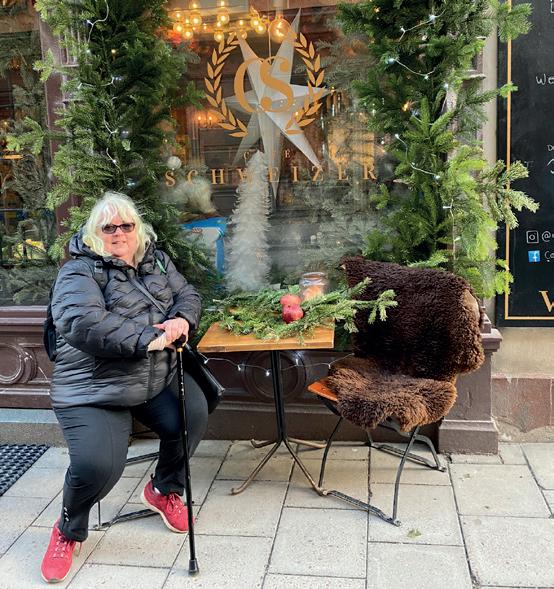
My friend and I got a table at Cafe Schweizer, where we warmed up with bowls of typical Swedish fish soup and homemade bread. Here, we learnt about the Swedish tradition of fika, meaning to sit down with family and friends and enjoy a coffee or tea with a piece of cake and take a well deserved break (even office workers follow this tradition daily).
Semlor buns were in season (previously only made on Shrove Tuesday, they’re now usually available throughout Lent), so we tucked into a couple of delicious, creamy

 By Heidi Roberts
By Heidi Roberts
buns stuffed with marzipan and whipped cream and flavoured with cardamom. A couple of minutes walk away was the Nobel Prize museum, housed in the ornate former Stock Exchange Building on Stortorget Square. Small but packed with interesting exhibits, it covers the past one hundred years-plus of the Nobel Prize and looks at how the work and ideas of
the winners and laureates have had an impact on science, culture and history. We rounded off our weekend with a trip out to Gamla Uppsala, a village about 45 minutes from central Stockholm on the train. Here, we immersed ourselves in Viking history, walking around ancient burial mounds and visiting a museum dedicated to life in Viking times. A replica of a Viking ship made me glad that I didn’t have to use that mode of transport to get home! As we travelled back to the city, the red houses and barns and huge open fields passing outside the window of the train reminded me of New England, where I grew up. The landscape made me feel at home, and made me even more determined to return.
Fish is important to the diet here, and you’ll find it fresh, smoked, salted, dried, and even fermented
Public transport is good from the airport to the city centre –use the UL app for easy tickets




Words: Rebecca Miles

The Canary Island that’s known as a ‘continent in miniature’, Gran Canaria has lots to explore. Head to the Maspalomas Dunes and the south for fantastic beach holidays, the capital Las Palmas de Gran Canaria for its charming old town and delicious gastronomy, and to the centre to explore the authentic side of this volcanic island, with scenic walks and plenty of stargazing.
The largest city in the Canaries, it’s easy to see why Las Palmas de Gran Canaria has become really popular with remote workers and digital nomads, who join the growing number of visitors looking for a great value city break. With a fun cosmopolitan atmosphere, it’s a delight to find the gorgeous Las Canteras Beach front and centre, or to meander the narrow streets of the old Vegueta quarter. It’s not short of great places to eat either – start at Mercado del Puerto for tapas, before heading to Mercado de Vegueta in the old town for incredible fresh produce. Lastly, don’t miss the new Poema del Mar aquarium, with jungle, reef and deep sea sections.
There’s a lot of sustainability to talk about in Gran Canaria, and leading the charge is the local food production. Thanks to the island’s climate, fresh food can be grown – and eaten – all year, so there’s no need for extensive food miles or intensive refrigeration processes – instead, just healthy and tasty food.
The island also places huge importance on getting back to nature, and supporting the communities with a variety of locally-led off the beaten track experiences.
BIOSPHERE RESERVE

In the centre of Gran Canaria you’ll find both a UNESCO Biosphere Reserve and the World Heritage Site of Risco Caído and the Sacred Mountains. Remote, otherworldly and unique, it’s an area that needs to be seen to be believed.


THE MIRADOR DEL PASO DE MARINERO
Also known as the Mirador del Balcón, the Mirador del Paso de Marinero viewpoint delivers both extraordinary views of the wildest parts of Gran Canaria, and the most sparkling of starry night skies. Arrive at the viewpoint in La Aldea on the west coast and prepare to be dazzled.
CAMINO DE SANTIAGO
A 66km trail that crosses from the north of the island to the south, the Camino de Santiago was an important communication route for the ancient inhabitants, before later being used by herders and then pilgrims. Now, it’s a challenging multi-day hike.
Venture away from the beach and you’ll be greeted with some unexpected delights on this island that’s rich in history and heritage. Explore pre-Hispanic sites and cave villages, visit coffee and tropical fruit plantations, or enjoy wine, honeyrum or cheese tastings. Tackle big hikes around Tirajana or the village of Tejeda, then settle into a slower pace of life in the island’s smaller towns and village – start with Arucas, Firgas and Agaete.
Beaches are a big deal in Gran Canaria. From the vast wild expanse of the Maspalomas Dunes and Playa del Inglés to the hard to reach hidden coves of Güi Güi and Playa de Veneguera, you’re never far from an idyllic stretch of sand. The lie of the land means the beaches on the south of the island tend to be more sheltered – and Puerto de Mógan is one of the prettiest here – while on the north they’re rugged, and often with swimming pools naturally formed in the rocks, such as at Sardina del Norte.

With its reliable climate year-round, Gran Canaria is a great destination for an epic sporting event or two. Whether as spectators or participants, runners, cyclists, swimmers, walkers and even windsurfers are catered for at events such as the Transgrancanaria Bike in May, the SwimRun Maspalomas Gran Canaria in June and the Gran Canaria Walking Festival in October.


Gran Canaria is home to Spain’s largest botanical garden, the Jardín Botánico Viera y Clavijo. Covering 27 hectares in the Guiniguada ravine in the north of the island, it’s home to over 500 species of indginous plants
Shining a light on community tourism, award-winning journalist Mark Stratton defines the idea for us, then, alongside two more writers, shares leading community tourism projects from around the world

The term ‘community tourism’ is increasingly heard in travel, but what does it actually mean? Community tourism needs to relate to localised ownership of a project or property, to fair pay, gender equality, the maintenance of traditional culture (unadulterated and not simply performed in song and dance shows), and ecological integrity.
On many occasions, especially on safari, I’ve been to lodges heralding their involvement with communities, along the lines of financing a new classroom or the like. Generous, of course, but ultimately maintaining a dependency culture, which will not benefit local communities long-term. Better to seek out a lodge funded, run, and established by indigenous people, like Sabache Camp in the Samburu, Kenya. This shining example is 100% built and owned
by the Samburu on their own land designated as a private reserve, with all tourist revenue going to the community’s 145 families. It embraces what every community tourism project should also aspire towards: a world-class tourism experience, not something to salve a holidaymaker’s conscience. Such initiatives may mean sacrificing creature comforts. After all, how many embroidered cushions on our beds or artistically folded towels do we need? In my story below from Om Koi I reflect on an emerging community ecotourism initiative where my mattress on the floor of a small wooden room and outdoors washing facilities proved basic facilities. But I felt really part of the community and, most importantly, bought into a radical initiative to alleviate captive elephants’ suffering while prospering the Karen hill tribe community.
Six-month old baby Valentine is out of control. Amid entangled jungle in the south-west of the Chiang Mai province, this baby elephant born on 14 February careens around like a ball-bearing in a pinball machine barging her mahout (her keeper) and forcing us, Om Koi’s first community ecotourists, to sidestep like artful matadors.
Its an unlikely ethical encounter with Thailand’s elephants, as all too often most tourists encounter them in riding camps maltreated and living in chains. But her mother, Moe-Pra, who gave birth to Valentine in the wild, is among 55 former captive elephants at Om Koi put back into their native jungle courtesy of an inspiring community tourism and elephant welfare

project initiated by a non-profit called Gentle Giants and the Karen indigenous hill tribe people.
As the co-founder of an Asian elephant welfare campaign called Friends of Bunka, I’ve investigated the woeful impact tourism plays in ensuring elephants endure wretched existences. Tourists who ride or bathe with elephants rarely see the mahouts deliver painful reminders of their control by sleight of hand, by nails or bullhooks. Such attractions deliver few lasting benefits to marginalised ethnic communities and normalise welfare abuse.
By 2020 Gentle Giants was fundraising to feed some of Thailand’s estimated 3,800 captive elephants that were experiencing a
welfare crisis as riding camps shut down during Covid. That’s when they heard about 55 elephants at Om Koi. These had been taken back from the camps to the jungles of their owners, the Karen, a Sino-Tibetan hill tribe people in northern Thailand. But their future looked uncertain.


“These elephants were to be sent to the logging industry as the owners had no choice but to rent them out to feed their families,” says Gentle Giants co-founder, Diana Munoz.

Gentle Giants was raising £28,000 per month to support Om Koi keep their elephants in their forest when the penny dropped on how they might make this arrangement self-sustaining. Launched in 2022, project Om Koi Evolution offers travellers an immersive homestay experience in hill tribe culture alongside viewing elephants interacting in their native habitat. Visitors’ £560 week-long fee goes entirely to the Karen villagers.
“The Karen were able to see a different way to make money from their elephants,” says Munoz. “Many of the men used to travel away with their elephants as mahouts to the camps and could be separated from their families for months. The project enables them to stay at home,” says Munoz.
It’s a seven-hour drive through ever-thickening jungle to Om Koi from the city of Chiang Mai. The village shaman, his toothless smile revealing red gums from betel nut consumption, welcomes us in traditional Karen fashion by leading the community in tying dozens of white cotton threads around our wrists.
Over a week, the villagers offer cultural activities combined with jungle treks to see elephants now at ease. I volunteer in the school helping the teacher with an English class. “Tell me ten things Thailand is best known for,” I ask the children. “Weed,” says a little girl with a ponytail, to the amusement of her classmates. The most arduous activity is a morning planting rice. Mid-calf deep in squelchy mud, I take handfuls of saplings and prod them into the flooded paddy, watched by the community bemused by my wonky rows.

Over a week, the villagers offer cultural activties combined with jungle treks to see elephants now at ease, and I volunteer in the school helping an English classKAREN VILLAGERS FAMILY BATHING
The Karen villagers are delighted with the project. “I want to see my young daughter growing up but need money to send them to school. Our elephants are worked too hard at the camps, and I was sorry for them. Now we all have a better life,” says village headmen, Chok Sai.
Our daily treks prove a unique experience in Thailand. We watch them reconnect with their wild instincts while the sightings are intimately close because they’re so unperturbed by human presence. And their mahouts have been repurposed to keep a watchful eye over them to ensure they do not stray too close to the village crops.
In a river bed choked with rattling bamboo, we meet a mother whose baby succumbed to the EEHV herpes virus (prevalent among captive elephants), yet shortly after she adopted a tiny, orphaned boy, Par-Gue-Meh, whose own mother died from ingesting agricultural toxins. He trails after his adopted mother, his stick-thin little trunk raised seeking milk. Their bond is deeply touching.

“We truly believe this can break the mould of abusive elephant tourism and within a prospering community setting it shows visitors how incredibly beautiful it is to see these gentle giants express themselves without fear,” says Munoz.
Coron Island, located in the northern part of Palawan province, is a true paradise. With pristine beaches, beautiful viewpoints, hot springs, worldclass diving spots and stunning sunsets, it’s no wonder that it’s regularly hailed as the best island in the world.
On the other side of the Philippines is Siargao Island, a teardrop island that’s the area’s surfing capital. Another beautiful spot, it’s facing challenges due to rapidly developing tourism, which is creating environmental

when Typhoon Kammuri hit Coron Island. I was stuck in my homestay (Joval Homestay) for two days, yet despite the chaos and amid the strong winds and heavy rainfall, power cuts, cancelled flights and boat tours, locals checked in on each other, came together to help other provinces, and remained positive. Their small actions of kindness and generosity reduced my anxiety and inspired me to support community tourism initiatives both on Coron Island and Siargao.
degradation, social disruption, and economic inequality.
Both of these tropical paradises are prone to cyclones, which I experienced first hand in December 2019
On Coron Island, community tourism initiatives aim to preserve its natural beauty while empowering local communities by providing them with sustainable
Their small actions of kindness and generosity reduced my anxiety and inspired me to support community tourism initiatives both on Coron Island and Siargao
income opportunities. Supporting these is a great way for holidaymakers to make a meaningful impact. One initiative is the Calamianes Association of Tourism Establishments, which offers eco-tours that showcase the island’s biodiversity and cultural heritage. Another is the Society for Sustainable Tourism and its Coron Initiative, which runs a community-based homestay programme that allows visitors to experience local life while supporting the community.
On Siargao, visitors can enjoy an incredible view point of coconut trees while participating in community-based tourism activities, such as homestays, cultural tours, and island hopping – the Sun Crew nonprofit is a good place to start. You can stay in a traditional Filipino house and learn about the local way of life, join a guided tour to visit a mangrove forest and learn about environmental conservation and beach cleaning, or go island hopping to discover hidden beaches and enjoy fresh seafood cooked by the Siargao people.
‘’Siargao island has undergone rehabilitation efforts to normalise the local tourism industry, local community initiatives to support those people who lost their jobs and livelihood from the typhoon devastation, especially those working in the tourism industry. Protection measures have been implemented to mitigate the impact of typhoons to the environment and locality,’’ says Zeny Pallugna, Regional Director, Philippine Department of Tourism.
As a traveller, I witnessed first-hand the resilience of the community and how they worked together to overcome the challenges brought about by the typhoon. This is the essence of community tourism – promoting sustainable tourism practices while supporting the development of the local communities.
I first visited Guyana in 2004 and immediately fell in love with its thundering waterfalls, pristine rainforest and highlands, wildlife-rich savannahs, colourful cultural heritage and tiny remote Amerindian villages. Often known as the land of six peoples, this little-known country is a cultural and multi-faith melting-pot arising from its unique geographical location at the crossroads of the Caribbean and South America, and its complex history of colonialism, sugar and slavery co-mingles with the many strands of its strong indigenous identity.
Home to nine different Amerindian peoples, including the Caribs, the Arawaks and the Makushi peoples, Guyana is one of the few countries where the indigenous population continues to thrive and where communityowned and led tourism goes from strength to strength, providing an important source of income to local villages as well as multiple socioeconomic benefits.
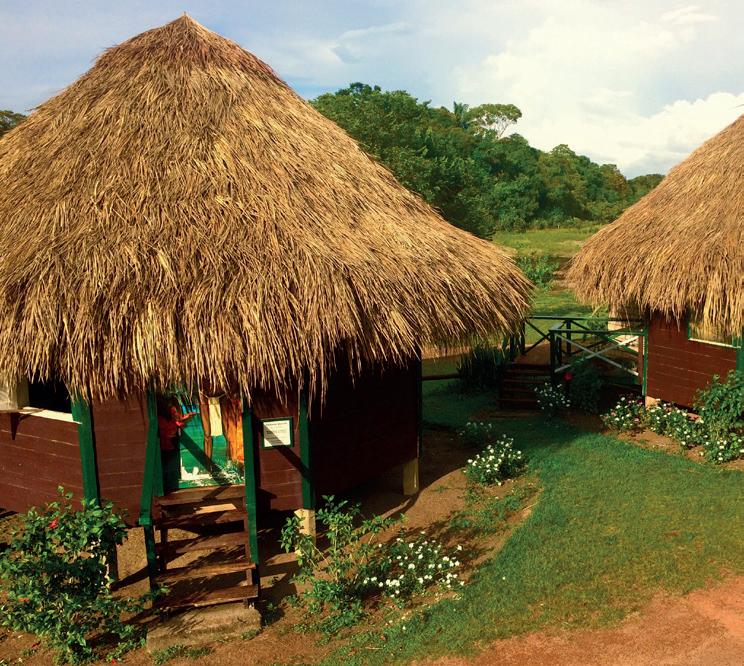
Winning multiple awards for its community tourism just prior to the pandemic and now with a twiceweekly British Airways direct flight from London, plus a burgeoning oil and gas sector, the eyes of the world are now on Guyana in terms of energy, conservation, investment and tourism.
There has never been so much demand to sample its rich biodiversity, stunning scenery and welcoming indigenous community lodges, such as Surama eco-lodge in the Rupununi district, which first opened its doors to travellers (among them the English naturalist Charles Waterton) back in the 19th century. By embracing tourism, this pioneering community has allowed its men to stay on their own land rather than be enticed away by the world of mining and logging. Warm interactions with international visitors have increased awareness and pride in their Makushi heritage and a popular cultural group has travelled around Guyana, singing traditional songs
from the village as well as new ones that incorporate the value of eco-tourism to the community. Here tourism has provided meaningful, paid and empowering employment that has allowed the village to put students through higher education, build a community airstrip and provide local transport. Suramas residents, especially the children, are personally invested in the preservation of the biological diversity that surrounds the village, leading
The excellent guides here take you on forest treks in search of Goliath bird-eating spiders, or a morning climb up Awarmie mountain for unparalleled views of pristine rainforest
visitors on hikes to nearby active harpy eagle nests, enforcing a ban on wildlife trapping, protecting groves of endangered bullet, letter, greenheart and waramaden trees, and introducing tourists and researchers to vast arrays of rainforest flora with time-honoured medicinal properties.
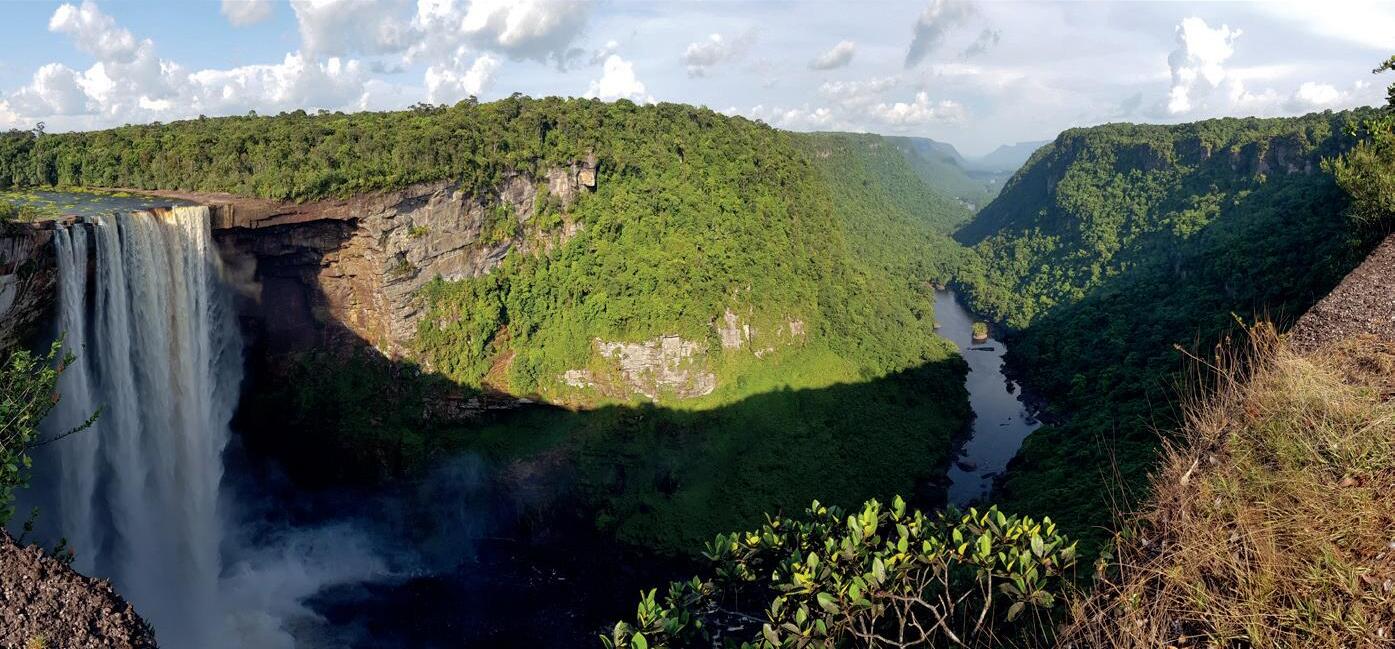
Much like a homestay, Surama ecolodge offers an easy introduction to the Amerindian way of life with guests’ needs looked after by the friendly team who offer home-
cooked meals prepared from homegrown foods with an indigenous influence, nature trails and canoe trips, mini-survival courses and the chance to hear local story tales, myths and songs. A favourite memory of mine is singing the Hokey Cokey with the whole school in the playground and watching the school ecology group perform the Birdy Song, with schoolkids dressed as local birds such as the bright orange Guianan Cock-of-the Rock. Further afield, the village of
Rewa can only be reached by boat and is now one of the leading community lodges in the country. Years of dedicated hard work allowed the villagers to build their own ecolodge which offers simple but clean, comfortable accommodation. Individual cabins are nestled at the forest edge with one of the best breakfast locations overlooking the river giving the chance to see giant river otter as you drink your coffee. The excellent guides here take you on village tours, forest treks in search of Goliath bird-eating spiders, or a morning climb up Awarmie mountain for unparalleled views of pristine rainforest and macaws flying beneath you. In the afternoon, visit oxbow lakes strewn with giant waterlilies and teeming with arapaimas, the world’s largest


Nerve Tumours UK, the national charity for those diagnosed with Neurofibromatosis Type 1 (NF1) and NF2-Schwannomatosis (NF2), funds a unique Specialist Support Network to help the 26,500 plus people living with these conditions in the UK, along with their carers, families, and wider support network, including medical professionals.
NF1 is one of the most common neuro-genetic conditions causing tumours to grow on nerve endings and with many associated medical, physical and psychological conditions e.g. Scoliosis, and 60% have learning disabilities. People live in constant pain.
More people are diagnosed with Nerve Tumours than those with Hereditary Muscular Dystrophy, Huntingdon’s Disease and Cystic Fibrosis combined, yet few including medics have heard of the conditions.
https://charitable.travel/nerve-tumours-uk/ info@nervetumours.org.uk nervetumours.org.uk


Head Office: 020 8439 1234 Helpline: 07939 046 030





freshwater scaled fish, which come to the surface to breathe air around you. A river drift back to the lodge via a fish barbecue on a sandbank with your local guides gives a chance to learn about the night sky and to look for black caiman, tree snakes and nocturnal birds, spotted with the help of a local guide, before a cold beer or a rum too at the Laughing Arapaima




bar back at the lodge. Conservation, science and eco-tourism merge at Caiman House Field Station, an outpost of research and hospitality located in the remote Amerindian village of Yupukari on the savannah lands along the banks of the Rupununi River. A popular night time excursion allows guests to observe, or become involved
with, the caiman research project which involves the capturing and assisting in data collection. This requires the caiman being weighed, measured and tagged before being released back into the wild and is one of the most exhilarating and exciting wildlife outings I have ever experienced on a sandbank in the middle of nowhere late at night. Profits from this friendly lodge support a public library, computers and internet for the village school and community. Another newly-launched community tourism project is a trekking and rafting adventure with the Arecuna people of Paruima in the Highlands, visiting three spectacular waterfalls along the way. More and more Guyanese communities are opening their doors to visitors to share and preserve their beautiful country and heritage while offering some of the most authentic and pristine travel experiences in the Americas.


In the latest Travel Insider Podcast, we visit Queensland in Australia. Home to such international cities as Brisbane and Cairns, it also has a staggering 4,000 miles of coastline off which lies its most famous landmark, the Great Barrier Reef – the world’s largest coral reef system.


While that glorious coastline has a habit of dominating things, venture inland and you’ll find ancient landscapes teeming with wildlife.
Our host Rebecca Miles is joined by two Australians, Kate Duffy from Tourism and Events Queensland, and Johnny Gaskell, a marine biologist and master reef guide, who share their favourite parts of this tropical region.
Covering everything from the Gold Coast and the Sunshine Coast, where surfers flock to the sandy beaches, to the Daintree rainforest, the oldest living rainforest in the world, as well as, of course, the incredible reef, Queensland is a must. Tune in to transport yourself to the other side of the world.
The largest of the Channel Islands, Jersey is curiously Brit-ish... It’s a place that’s familiar but with a delightfully continental twist, and it’s a place where you’ll quickly and easily feel on holiday. The sunniest spot in the British Isles, it’s just a short flight or ferry ride away from the UK mainland and once there, you’re never more than 10 minutes from the beach.

Joining Rebecca to talk all things Jersey are Kary Day, a Blue Badge tour guide with Jersey Uncovered, and Sarah Barton from Visit Jersey.

Are you hearing the call of the open road? Are you ready for spirit-soaring landscapes, dazzling skies and thrilling outdoor adventures? There’s a place in the United States where you’ll find all these things and more; whenever you choose to go, and however you choose to explore.
The Great American West exists so you can tick ‘Ultimate US Escape’ off your dream holiday list – so now you’re just left with deciding which of the 15 national parks, 150 state parks, numerous historic monuments, authentic cowboy towns and countless other attractions you’ll visit first in these five spectacular northern states. Even alone, Montana, Idaho, Wyoming and North and South Dakota conjure iconic images

of mountains rising to meet big skies; tumbling rivers and rumbling buffaloes; Wild West towns and Native American powwows; pine-clad valleys and cowboys riding across the plains.
Together, the five epic states of the Great American West are a force of nature, and to travel here is to travel to the heart of America’s story: to discover the culture, stories and passion of the land’s indigenous people, and understand the struggles and dreams that drove those who came after.
Ready to answer the call?
The Great American West awaits...
Read about more adventures in the Great American West at charitable.travel/northamerica/the-greatamerican-west
Celebrate the gold-rush which earned the ‘Treasure State’ its name with a visit to the sites of the ‘Richest Gold Strikes in the Rocky Mountain West.’ Step back to the 1800s in Nevada City’s living history museum, then ride the Alder Gulch Shortline Railroad and wander the Virginia City Historic District.
Soaring mountain vistas, sparkling glacial lakes and sacred Native American sites: open yourself up to the magic of Montana

“Keep close to Nature’s heart... and break clear away, once in a while, and climb a mountain or spend a week in the woods. Wash your spirit clean.” The words of naturalist, John Muir, were made for Montana. The ‘Father of the National Parks’ inspired the preservation of America’s wild places, and ‘Big Sky Country’ has two of the most spectacular protected areas in the National Park System: Glacier and Yellowstone. In the former, more than 200 waterfalls, towering peaks, indigenous sacred sites and its famed glaciers provide the backdrop for 700 miles of hiking trails in Glacier National Park, which dazzles with russet and gold foliage in autumn, while the latter, Yellowstone – designated the first US National Park in 1872 – is a hotbed of geothermal activity and a hotspot for wildlife, including wolves,
bison and bears. Between the two lies the funky town of Missoula, with its boutiques, restaurants and bars, and a three-hour drive leads to the First Peoples Buffalo Jump State Park, where Indians stampeded buffalo over the mile-long precipice for hundreds of years, prior to the Lewis and Clark Expedition passing through. Boat tours near the state capital, Helena, follow in the explorers’ wake along the Missouri River, leading to the towering cliffs named by Lewis as the Gates of the Mountains. But in Montana, you don’t need to be going anywhere in particular to have an adventure: roads like the 64-mile Anaconda-Pintler Scenic Route are the destination, passing through some of the most breathtaking alpine landscapes in the Great American West.
North American Indian Days – the ‘Celebration of Recovery’ is one of the largest powwows of United States and Canadian tribes. July; Browning Montana Folk Festival is a giant free festival featuring over 200 acts from the nation’s best performers appearing across six stages. July; Butte
Surrounded by the dramatic landscapes of Glacier Country, Flathead Lake is the largest natural freshwater lake in the west, stretching over 200 square miles. Offering boating, swimming, water-skiing and camping, the southern half of the lake lies within the Confederated Salish and Kootenai Tribes of the Flathead Nation Reservation.
Winter, late-autumn and early spring are prime times for some Northern Lights action in the skies above Montana. Head to Bozeman, Billings and Kalispell for some aurora spotting just out of town, or immerse yourself in the lightpollution-free wilderness of Glacier National Park for a mesmerising display.
Find

Whatever the season, the city of Coeur D’Alene has plenty of places to play your days away, from riding the rollercoasters of Silverwood, the largest theme park in the Northwest, to kayaking on the lake, golfing on the city’s famous floating green, or skiing and snowboarding at three nearby mountain resorts.
Despite its devilish name, Hells Canyon reveals some heavenly scenes from its rim, 1.5 miles above river level, and depending on your need for speed, North America’s deepest river gorge can be explored on a whitewater rafting adventure, or a jet boat tour through the deepest and most rugged parts of the canyon.

Following the path of the old Milwaukee Railroad, which crossed the Bitterroot Mountains between Idaho and Montana, the 15-mile Route of the Hiawatha mountain bike and hiking trail passes through 10 long, dark train tunnels and across seven trestle bridges, offering beautiful views of the forest-clad peaks.
Find more reasons to visit Idaho charitable.travel/northamerica/the-greatamerican-west
With the largest contiguous expanse of wilderness in the continental USA, Idaho is a nature-lover’s dream, and a treasure trove for fossil hunters and stargazers, too

Nowhere does the Great Outdoors better than Idaho, and however you choose to explore, you’ll find a trail leading to natural treasures in America’s ‘Gem State’.
One of just two places in the world where the rare star garnet can be found (India is the other), Idaho is known for its abundance of minerals, but as well as rockhounding for garnets, visitors will dig the Hagerman Fossil Beds National Monument, too, with its four-million-year-old animal fossils from the Pliocene epoch.
With more miles of whitewater rafting routes than any of the lower 48 states, the southwest capital city of Boise and mountain resort McCall are hubs for exciting river adventures, plus rock climbing and hiking, horse riding and biking through the forest, while Payette
Lake is a playground for sailors, kayakers and paddle boarders. In winter, there are glistening snowmobile trails to ride starting in Bear Lake and Priest Lake State Parks, and 19 ski areas across the state to channel your inner Gwynnie. Idaho’s vineyards and breweries produce world-class tipples for some well-deserved après-ski, and more than 100 natural hot springs will soothe away any aches and pains after a day on the slopes.
Canopied by some of the darkest skies in the USA, Central Idaho Dark Sky Reserve, City of Rocks National Reserve and Bruneau Dunes State Park offer excellent star gazing by night, and don’t miss some cosmic viewing of the lava field kind at the otherworldly Crater of the Moon National Monument and Preserve.
Founded in 1911, War Bonnet Round Up is Idaho’s oldest rodeo, and includes riders from the Native American Shoshone-Bannock Tribes of Fort Hall. August; Idaho Falls
Established on 2 May 1924, Craters of the Moon National Monument and Preserve will mark its centenary with celebrations in 2024. May; Arco
Just 50 miles south of the Canadian border, the city of Minot lies in the scenic Souris River Valley, surrounded by prairies which bask under some of America’s best sunrises and sunsets. There’s birding and kayaking in six wildlife refuges nearby, and from October to March, look out for the Aurora Borealis.
Home to seven Native American tribes, the Peace Garden State is rich in history, with legends brought to life at historic sites across this rugged, untamed land
“I never would have been President if it had not been for my experiences in North Dakota,” said Theodore Roosevelt, who made his first trip to the region in 1883 to hunt buffalo. Roosevelt later owned cattle ranches in what was to became known as the ‘Roughrider State’ – named after the cavalry he organised to fight in the SpanishAmerican War – and today, Theodore Roosevelt National Park commemorates the President’s years in the Badlands. North Dakota is a place of legend. Sitting Bull, the Native American chief who led the Sioux tribes against settlers taking their tribal lands, and Lewis and Clark, and Sakakawea, the Lemhi Shoshone woman who helped guide their expedition, have all left their mark here.
The Lewis and Clark Trail leads through the state capital, Bismarck,
and unspoiled landscapes first seen by the explorers, while the Interpretive Center at Fort Mandan shares their story and Knife River Indian Village National Historic Site honours the place where they met Sakakawea. Visitors can learn about the lives of the Mandan Native Americans at Fort Abraham Lincoln State Park, which includes a reproduction of the house of Lt. Col. George Armstrong Custer, famously killed during the battle with the Lakota Sioux, Northern Cheyenne and Arapaho tribes at Montana’s Little Bighorn. And North Dakota’s rugged landscapes are legendary, too. Explore the Badlands’ 144-mile Maah Daah Hey Trail on foot, horseback or bike, or take a hike in the Pembina Gorge State Recreation Area, one of the largest uninterrupted stretches of woodlands in the state.
The United Tribes Technical College International Powwow draws singers and dancers to compete, and artisans to display traditional Native American crafts. September; Bismarck-Mandan The largest event in the state, 300,000 people visit the North Dakota State Fair to watch live music and entertainment acts, plus a rodeo. July; Minot
Opened in 1932, the International Peace Garden straddles the international boundary line between North Dakota and Manitoba in Canada, and claims to be the longest unguarded border in the world. A symbol of friendship, the gardens bloom with more than 150,000 flowers and offer hiking, biking, kayaking and cross-country skiing.

A symbol of the Great American West, the buffalo is a big deal in Jamestown, which honours these iconic animals and the essential role they’ve played in the lives of Native Americans with a National Buffalo Museum, the World’s Largest Buffalo statue, and an impressive herd of 30 bison.
Start planning your own legendary trip to North Dakota charitable.travel/northamerica/the-greatamerican-west

Standing on the bank of the Missouri River, state capital Pierre, is the perfect place to dive into South Dakota’s history, and the collections at the South Dakota Heritage Centre preserve the cultural legacy of the Sioux tribes and early European settlers.
The largest city in South Dakota, Sioux Falls blends natural beauty with exciting urban life, and is one of the few spots in the USA where you can canoe straight through Downtown. Enjoy hiking and biking in the stunning Falls Park by day, and exciting nightlife in the city’s neighbourhoods after dark.
Get ready to head back to your childhood (and run down that hill!), with a visit to the Ingalls Homestead made famous in Little House on the Prairie. This feel-good attraction in De Smet has wagon rides, traditional craft workshops, and offers a glimpse into life on the wild frontier.
Discover more about South Dakota charitable.travel/northamerica/the-greatamerican-west
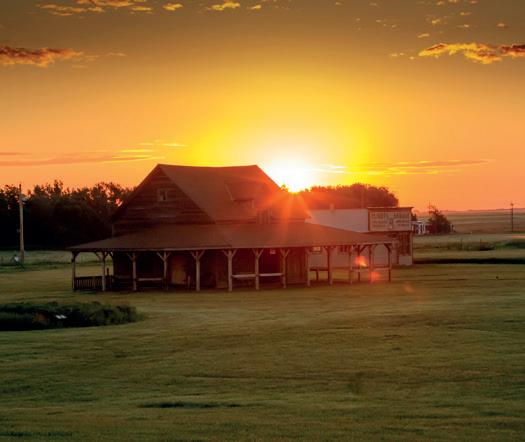
Explore rolling prairies, granite peaks and towering forests, before coming face-to-face with both sides of America’s heritage in the Mount Rushmore State

With incredible vistas from the Great Plains to the Black Hills, Badlands and beyond, South Dakota is home to one of the largest concentrations of parks and historic monuments in the Midwest.
To the east of the Black Hills, Badlands National Park protects one of the richest fossil beds in the world, and offers incredible hiking and biking through a supernatural terrain of ridges, canyons, pinnacles and spires. The Missouri River runs through the state, and along with glittering lakes – including five in Custer State Park, known for its huge roaming buffalo herd – offers plenty of opportunities for wet and wild adventures. Stop off at Deadwood, an authentic 1800s Gold Rush town in Black Hills National Forest, to replenish in one of the many spit-and-sawdust saloons.
At South Dakota’s most famous landmark, Mount Rushmore, you’ll
gaze in the face of history, in the shape of the four enormous carved heads of US Presidents George Washington, Thomas Jefferson, Theodore Roosevelt and Abraham Lincoln, and at nearby Crazy Horse Memorial, see the site which was the Native American response to it. “My fellow chiefs and I would like the white man to know that the red man has great heroes also,” said Chief Henry Standing Bear, when commissioning the world’s largest mountain carving. Looking out over the Lakota tribe’s sacred Black Hills, the monument in-progress honours Standing Bear’s cousin, the Lakota warrior, Crazy Horse, and helps develop cross-cultural understanding at the memorial’s Indian Museum of North America and Native American Education and Cultural Centre.
The Sturgis Motorcycle Rally is one of the biggest biker gatherings in the world, with concerts and rides through the Black Hills and Badlands. August; Sturgis The most popular organised hike in the USA, the bi-annual Crazy Horse Vollksmarch is a 6.2-mile woodland ramble at Crazy Horse Memorial. June; Crazy Horse
With awe-inspiring red canyons that pop against Wyoming’s clear, blue skies, Flaming Gorge National Recreation Area offers exciting water sports on the reservoir and river, including tubing, water-skiing and jet skiing, or explore on foot or by bike on the miles of spectacular trails, sometimes roamed by wild horses.
The least-populated state in the United States is ripe for a true Wild West adventure, with authentic guest ranches and stunning rugged vistas


Gateway to the epic wilderness of Yellowstone and Grand Teton National Parks, Wyoming is a land where superlatives are the norm, not the exception. Yellowstone’s unparalleled geothermal activity bubbles and blasts throughout the park, with the world’s most famous active geyser, Old Faithful, erupting 20 times a day, shooting water up to 180 feet in the air, and the largest hot spring in the USA: Grand Prismatic Springs. Yellowstone is one of the most near-in-tact ecosystems left on the planet, and is home to wolves, bison and both grizzly and black bears, and its Lamar Valley is one of the world’s best wildlife viewing regions. Smaller than its neighbour – but still perfectly formed – Grand Teton is a marvel of granite, snowcovered peaks and pines, with over
200 miles of trails to explore. This still-wild frontier is known as the Cowboy State, and visitors can saddle up for a trail ride, chow down at cowboy cookouts, and step back in time in Cody, established more than a century ago by legendary soldier-turned-Wild-West-showman, ‘Buffalo Bill’ Cody, and still known for its warm Western welcome. Artists, makers and foodies flock to the friendly city of Casper, while Jackson Hole is a mecca for skiers in winter and climbers and paragliders in summer. And for a truly outof-this world experience, head to Devils Tower National Monument. Sacred to American Indians, this mesmerising 867-feet-high butte is the focus of extraterrestrial action in the Steven Spielberg classic, Close Encounters of the Third Kind
Wyoming’s state capital hosts Cheyenne Frontier Days, a huge event with a rodeo, carnival and live music, which brings the Western culture to life. July; Cheyenne Shoshone Indian Days celebrates traditional Indian culture with dance competitions, food, arts and crafts. There’s a parade and carnival games, too. June; Fort Washakie
Watch the wandering bison herd, go hiking or biking, and enjoy the multi-hued terraces that line the Big Horn River, before taking a plunge into the world’s largest mineral hot spring at Thermopolis’s Hot Springs State Park. Wyoming’s first state park’s healing waters maintain a steady 40°C.
Wyoming’s cold sagebrush desert is full of prehistoric secrets: fossilised birds, mammals, fishes, insects and more, which can be seen upclose at the wonderful Fossil Butte National Monument, known as America’s Aquarium in Stone. Once the site of a freshwater lake, the fossils are an astonishing 52 million years old.
Plan your future roam around Wyoming charitable.travel/northamerica/the-greatamerican-west
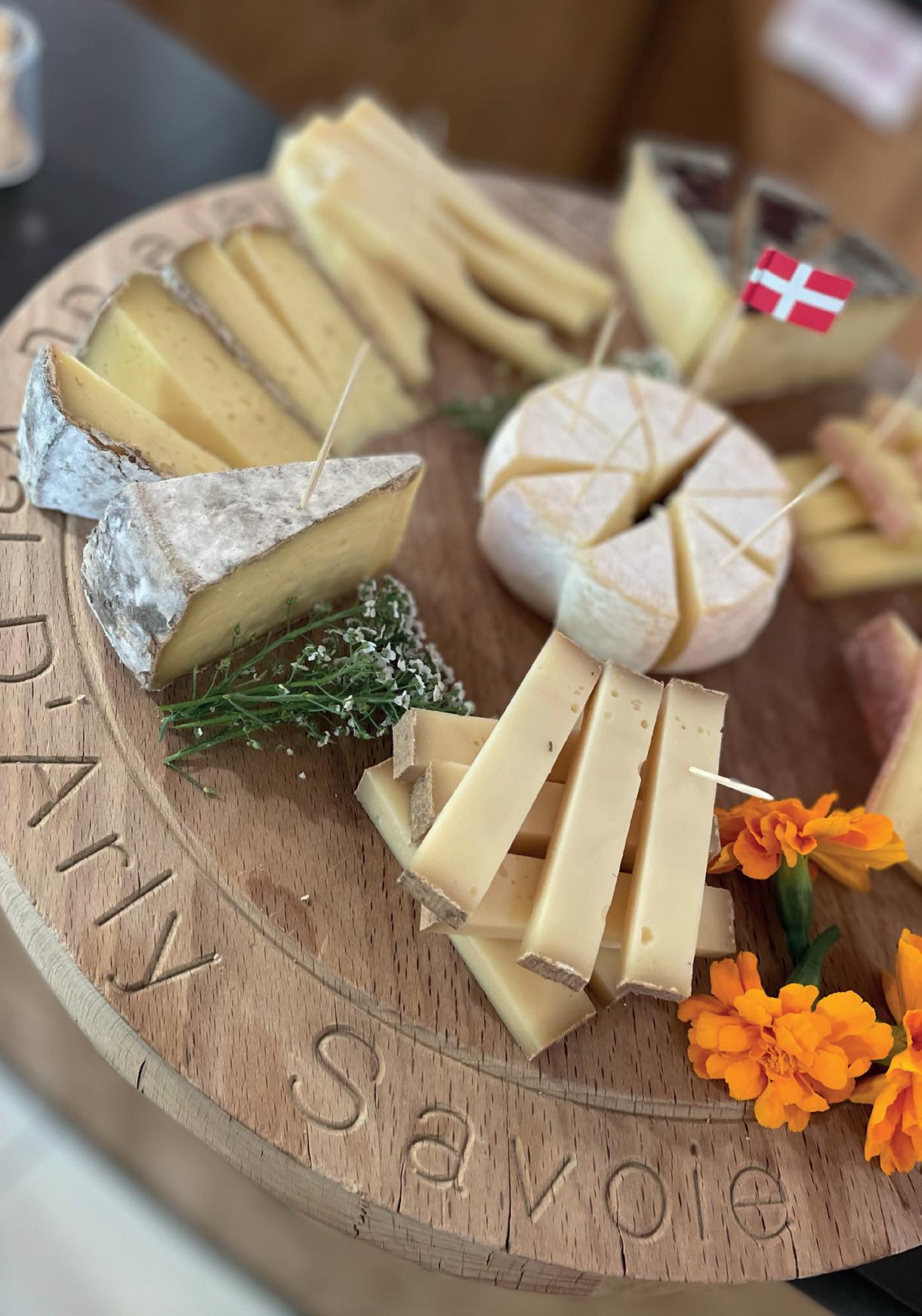
Here, the farmers are getting younger, not older and a new generation are injecting vitality into the local traditions, particularly cheesemaking. The lush Alpine pastures provide the cows, sheep and goats with all they need for their milk to be turned into delicious Reblochon, Beaufort, Tomme and Raclette cheeses.
Swap the sea for the pretty swimming lake at the edge of Flumet, Val d’Arly’s main village. Ideal for swimming and relaxing, it’s surrounded by trees if you need a shady spot, and there are plenty of picnic benches, two cafes and a diving platform and towering fountain in the middle of the water. Alternatively, opt for a paddle in one of the many mountain streams.
A set of four mountain villages in the French Savoie Mont-Blanc region, tradition meets the 21st century here


Val d’Arly is surrounded by the Aravis, MontBlanc and Beaufortain massifs, so walking through stunning scenery of green meadows and dramatic peaks is second nature. But you’ll also find more unusual landscapes, such as this, the Arpelières trail through ancient peat bogs and wetlands that feels more Scandinavia than French Alps.
Take a cycling tour of the villages of Val d’Arly. The Tour de France regularly races through and climbs its cols (notably the Col des Aravis), or take it easier on an e-bike. This is medieval Flumet, with plenty of local cheese and charcuterie producers, but also visit charming Notre Dame de Bellecombe, livelier Crest-Voland and tiny La Giettaz.


Humanitarian crises around the world – from the war in Ukraine and the conflict in Sudan to the earthquakes in Syria and Turkey and the Taliban takeover in Afghanistan – mean more and more people are having to flee their homes. These charities are doing all they can to provide refugees and asylum seekers with a warm, supportive welcome and to help them rebuild their lives in the UK
Supporting people affected by displacement and exploitation, Migrant Help UK helps them thrive as individuals and recover from their trauma. Core services include asylum support, slavery and human trafficking support, and refugee resettlement, and the charity has 14 offices across the UK plus operates a free helpline. Set up by Helen Ellis MBE in 1963, the charity marks its 50th anniversary this year. migranthelpuk.org
Reading is a foundation for what
Donate today at charitable.travel/book-aid

Millions of people live in a world without books. Just £2 could help to send a brand-new, carefully selected book to a reader like Maame. bookaid.org
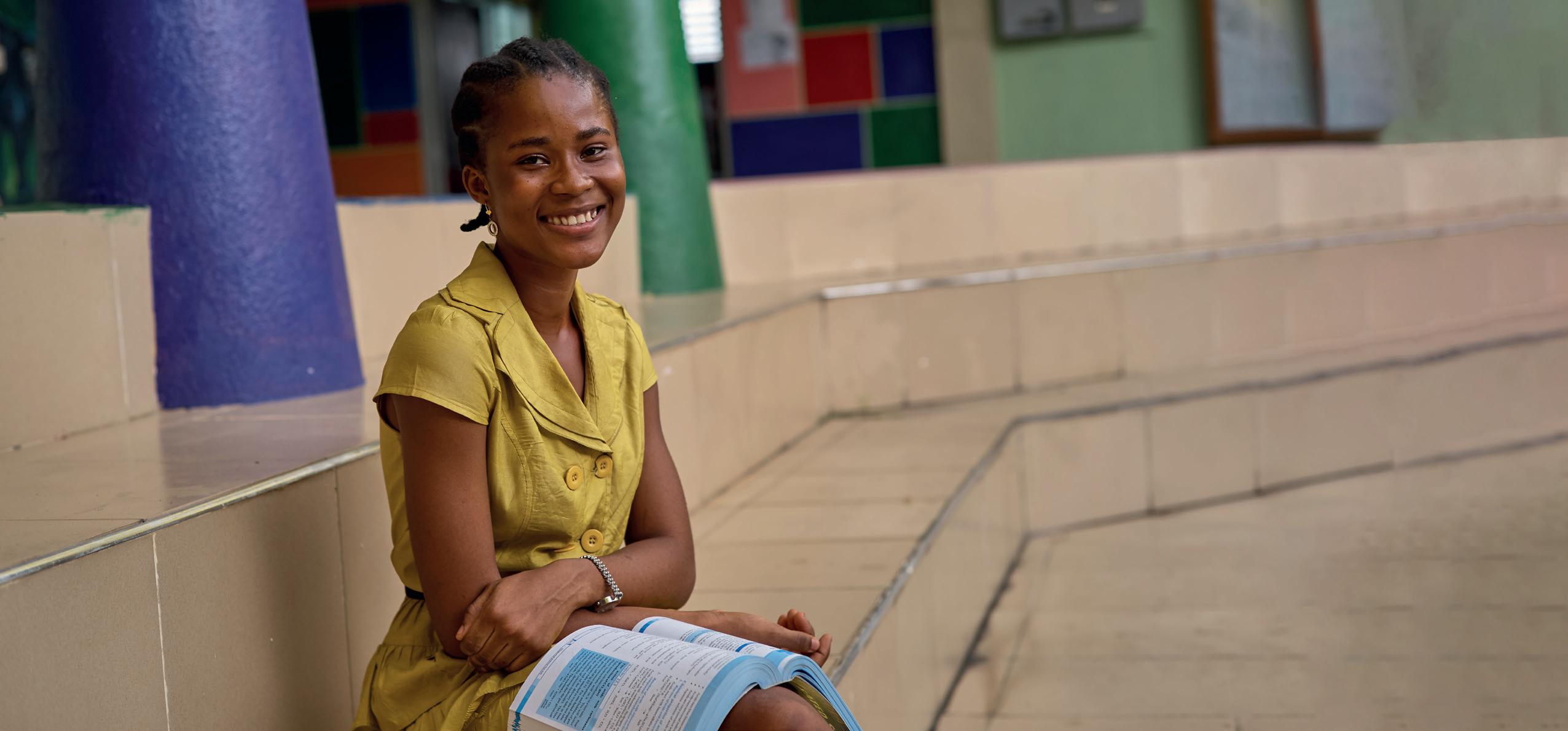
I want to achieve in the future.
Being a lawyer has always been my dream. I want to be a voice for the voiceless.”
17, Ghana

In operation for nearly 40 years to provide assistance to Afghans in hardship and distress, since the Taliban takeover in August 2021 Afghanaid has been responding to the humanitarian crisis with emergency assistance, providing food, shelter, cash and other vital household essentials to the most vulnerable. Afghanaid’s work also involves supporting returning refugee families, particularly from Pakistan and Iran, who are moving into communities already struggling with conflict and poverty. afghanaid.org.uk
Standing up for refugees and people seeking asylum, for 35 years Refugee Action has been helping refugees who’ve survived some of the world’s worst regimes to build safe, happy and productive lives in the UK. The charity also works towards creating a fairer and more effective asylum system, enabling local services to work together more effectively, and removing barriers to employment and integration by improving access to English classes. refugee-action.org.uk
Founded in 1951 following the creation of the UN Refugee Convention, the Refugee Council exists to support and empower people who have fled conflict, violence and persecution to rebuild their lives in the UK. The charity provides crisis advice, mental health counselling and practical support to help people integrate into communities, and specialises in working with children who arrive in the UK alone. Campaigning for improvements to the asylum protection system and speaking out for fairness and kindness is at the heart of everything it does. refugeecouncil.org.uk

Founded at the call of Albert Einstein in 1933, the IRC works in over 40 crisis-affected countries as well as communities throughout Europe and the Americas, helping people affected by humanitarian crises to survive, recover and rebuild their lives. Responding within 72 hours to conflict and natural disasters, the IRC stays to help countries stabilise. If necessary, it then helps resettle refugees and supports refugee integration. rescue.org/uk
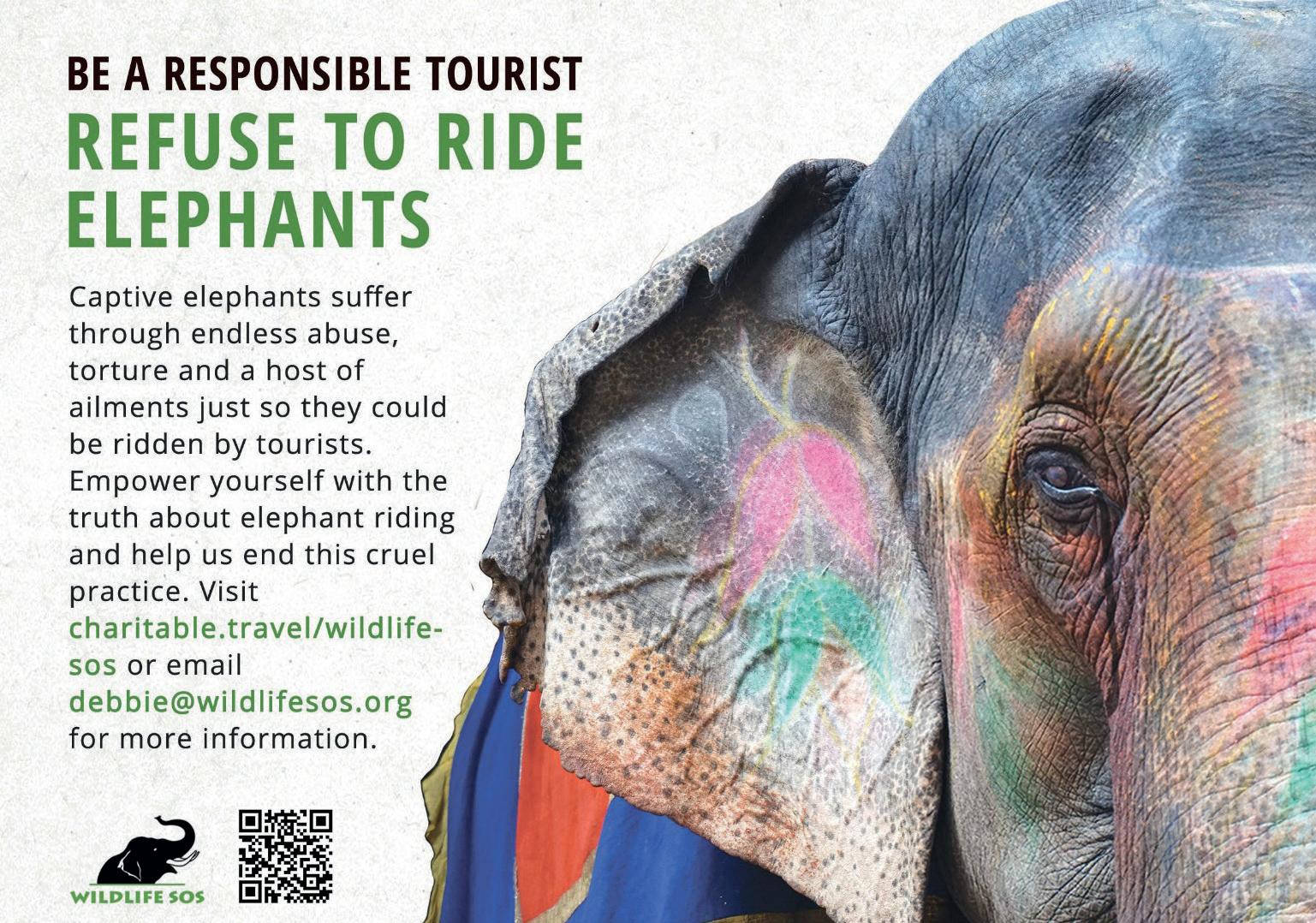
Heartfelt delights meet seductive style at the charismatic Virgin Hotels where “Everyone Leaves Feeling Better”. Step inside these hotels and find your new favourite space – where the doors are never closed and the minds are always open. These captivating lifestyle hotels are all you’ll need with the best restaurants, bars and lounges so work and play are all at your fingertips.

Dallas has a new work of art in the Dallas Design District. We’re thrilled to say it’s us. We’ve reimagined what a boutique hotel in Dallas can look like — and what it can do. Discover our Chambers, which put you in the driver’s seat. See how global trends inspire the cocktails and cuisine at Commons Club or take in a breath-taking local view of the city skyline from The Pool Club, our 4th floor rooftop. And we’re just getting started. Step inside to find your new favourite place to be in Big D.
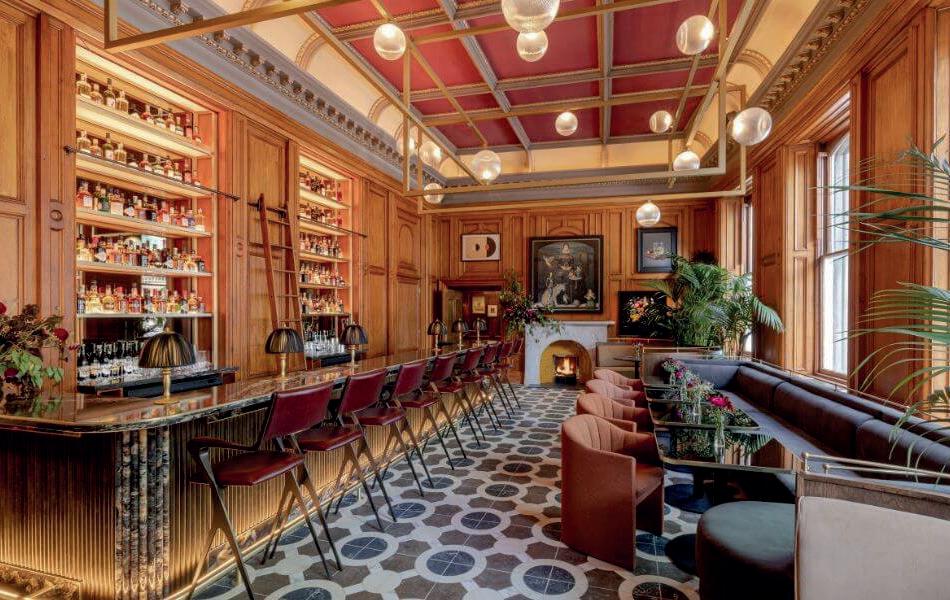
7 nights from £1,819 per person
Think you know what Scottish luxury looks like? Think again. Situated in the historic India Buildings, Virgin Hotels Edinburgh is reimagining the Old Town, marrying its iconic Victorian architecture with distinctive, contemporary design. Inside the hotel, you’ll experience a world that revolves around you – from our signature chamber design to numerous drinking, dining and entertainment options that you’ll never want to leave.
7 nights from £1,325 per person
Situated in NoMad, giving you incredible views of the Empire State Building and Lower Manhattan from the terrace at Everdene and The Pool Club. Explore The Big Apple by day, and then retreat to the oasis of Virgin Hotels New York City. With palate-pleasing, creative, and refreshing food and beverage options available in engaging atmospheres, and beautiful Chambers with floor-to-ceiling windows, custom sensor lighting, a full vanity, and other amenities.
7 nights from £2,625 per person

Visit the Windy City in style, by staying in the Virgin Hotels Chicago. In the heart of the Loop in downtown Chicago, and near the Chicago Theatre, this boutique hotel is steps from Magnificent Mile and Millenium Park. Visit Cerise rooftop bar for mouthwatering cocktails and breath-taking views of chi-town. Plenty of places to brunch, drink, and dine in house, combined with sleek-looking and comfortable rooms, and Virgin’s iconic customer service await your arrival.
7 nights from £1,495 per person

Where the cool kids kick back- Whether you prefer to sleep in or step out, these digs provide the freedom to do your thing, whatever that may be. Our lifestyle-focused chambers are split by a sliding set of privacy doors that creates two separate areas, one for rest and one for revival. With beds that surprise and delight, inroom treats, and a vanity to die for – no wonder we predict this to be your new place in the city. With 12 dining options, 4 bars and lounges, 5 entertainment venues and of course a casino there is more than enough to delight you where what happens here only happens here.
7 nights from £1,275 per person
Virgin Hotels New Orleans mixes a passion for food and beverage with music and culture that fuses with the Crescent City’s unique personality, providing an inclusive environment for travellers and locals alike. Located in the Warehouse District, you’ll be steps away from New Orleans’ iconic venues and destinations, such as the French Quarter. Relax in our uniquely-designed twochamber rooms with a dressing room and sleeping area separated by a sliding door. Visit The Pool Club rooftop bar for sips, dips, and views of the Big Easy.
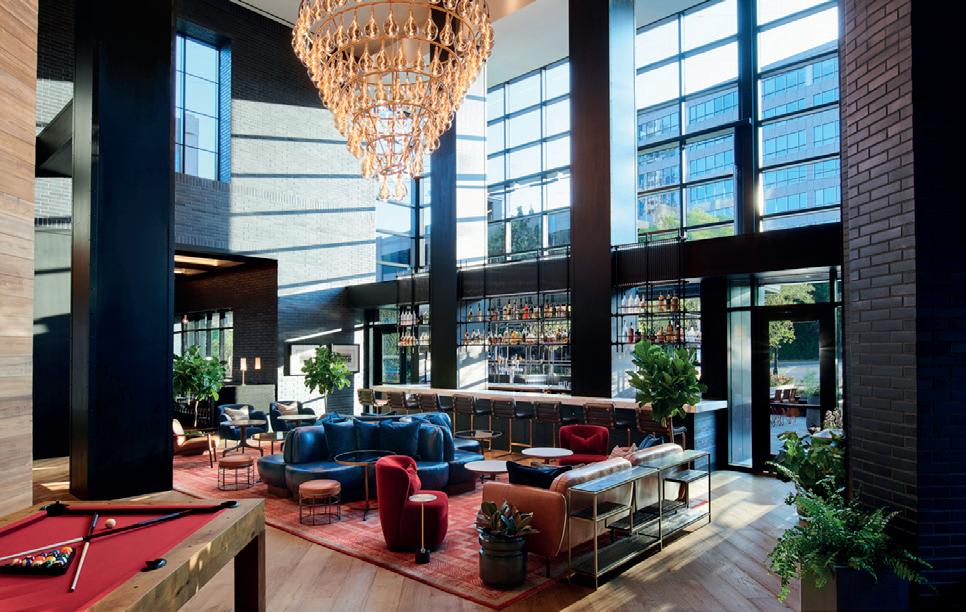


7 nights from £1,289 per person
We’re here to turn the volume all the way up in Music City. Stay in our reimagined boutique hotel, just minutes away from downtown Nashville, and experience the charm of Virgin’s commitment to customer excellence combined with a touch of Southern charm and hospitality. With live events, great food, and beautifully designed Chambers, Virgin Hotels Nashville is the only place you’ll need.
7 nights from £2,215 per person

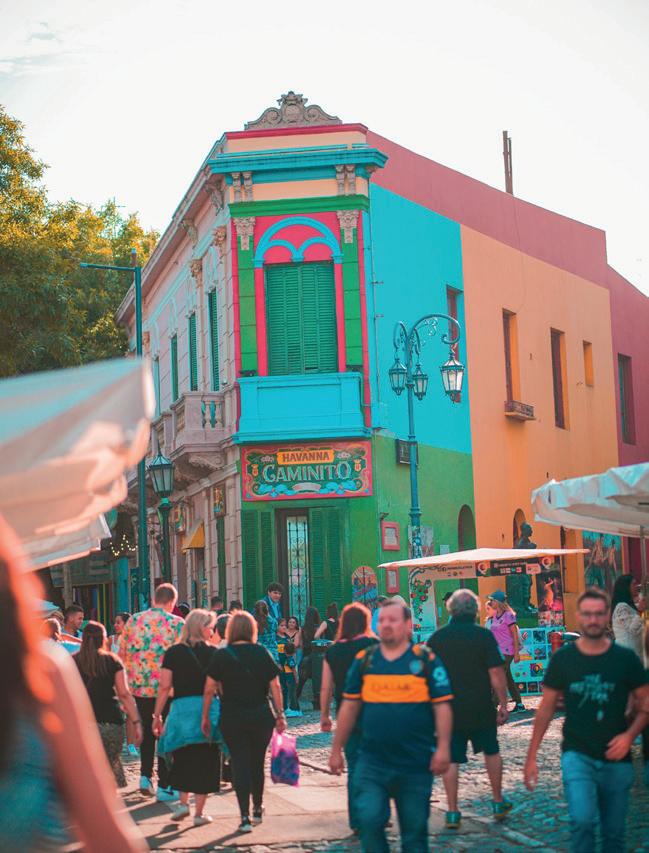
The ‘Paris of the south’, Buenos Aires is glamorous, seductive and full of energy. Whether that be from the tango dancers that perform in the city’s streets, restaurants and theatres, or the packed bars, historic cafes and heaving nightclubs, BA is a city that never sleeps. Which is good, as there’s so much to see and do, from strolling the streets of the colourful La Boca neighbourhood or the bohemian San Telmo via the many lively plazas and parks, to enjoying some of the world’s best beef and red wine at one of its many steakhouses.

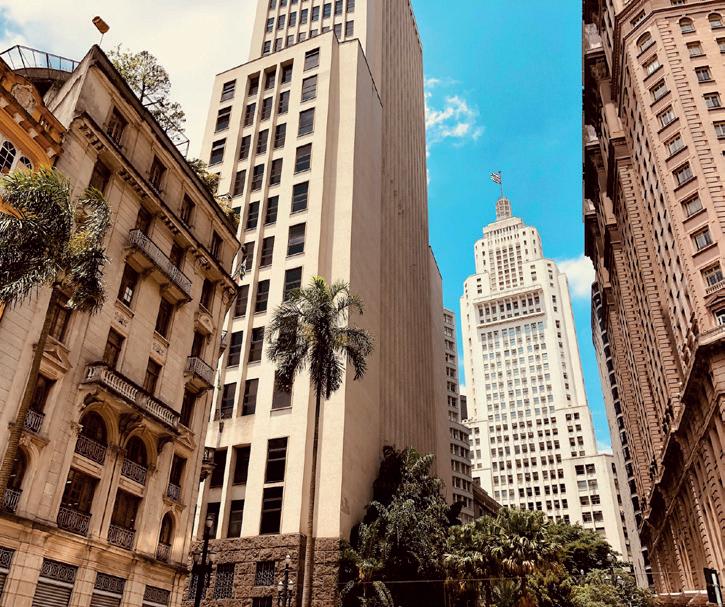
While Rio de Janerio may take most of the urban glory in Brazil, São Paulo deserves a look too, thanks to its fully fledged foodie scene, rich architectural traditions and the city’s largest park, Ibirapuera. Here, you’ll find two of São Paulo’s most significant art galleries in a space designed by landscape architect Roberto Burle Marx. Don’t miss the belle époque covered market Mercado Municipal, the city’s oldest church São Bento (that dates back to 1598) and Sé Cathedral, a gigantic neo-Gothic beauty.
A port city on the Caribbean coast, Cartagena is a warm and friendly mix of walled Old Town with cobbled streets and packed squares, and buzzing beach destination with white sand and palm trees. Known for having one of the best food scenes in South America – from high-end restaurants to street food, as well as the iconic Palenqueras – brightly dressed Afro-Columbian women from the first freed slave settlement in the Americas, there’s much to celebrate in Cartagena.
With the snow-capped Andes in the background, much of your time in Santiago can be spent simply admiring the views. And while they’re definitely worth some of your time, be sure to also see all the grand architecture, most striking of which is the Centro Gabriela Mistral, a cultural, performing-arts and gallery space, and roam through the vast Parque Metropolitano, otherwise known as Cerro San Cristóbal.
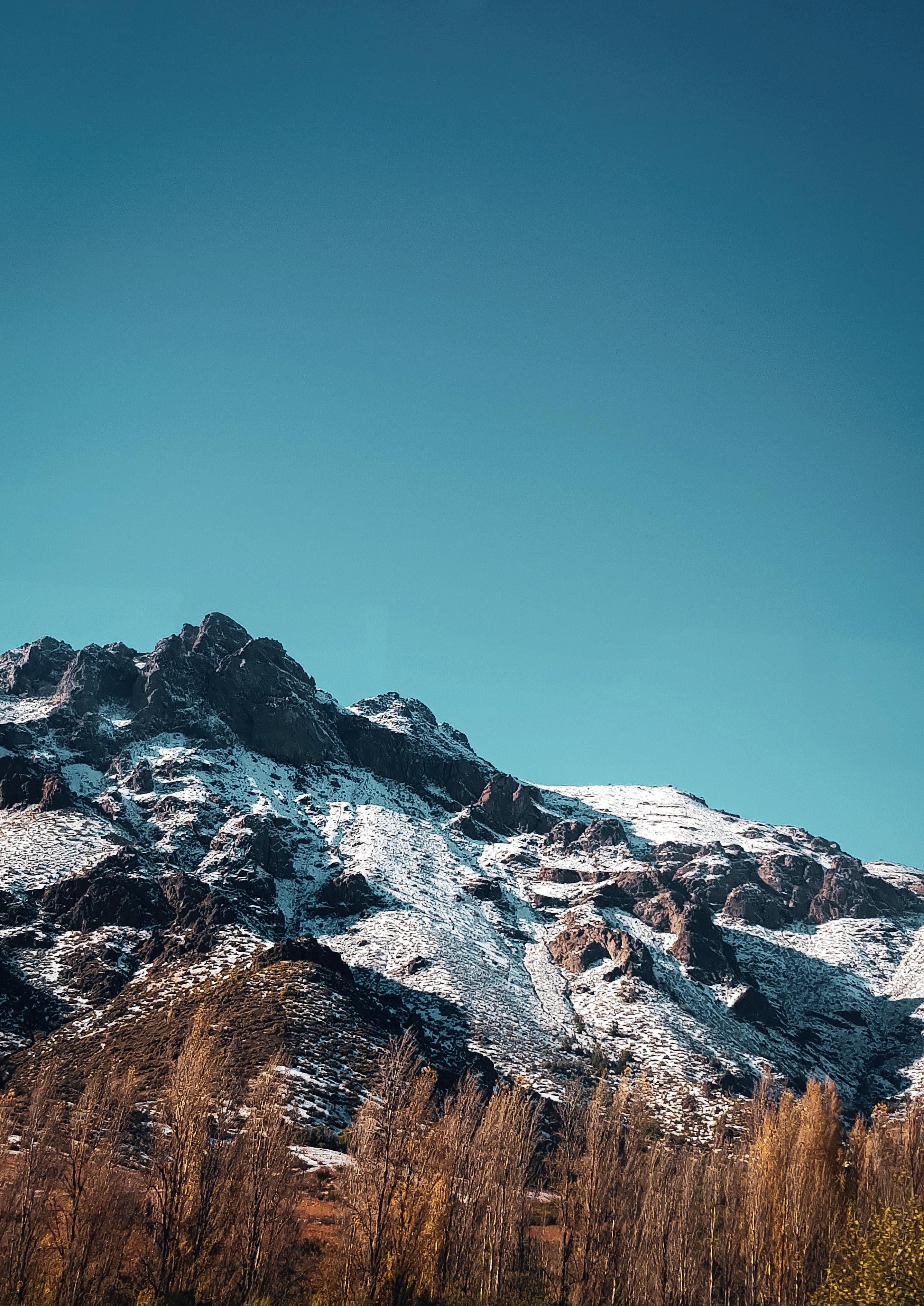
Sat between the Amazon and the Andes, the views alone from La Paz make it worth the visit. The world’s highest city, La Paz will literally take your breath away, but once you’ve got used to the altitude explore the city on its rapidly growing network of cable cars (way better than a bog-standard bus) and experience some indigenous Aymara traditional culture before dancing the night away in its boisterous bar and club scene.

In a continent filled with some of the most jaw-dropping natural wonders in the world, South America’s cities do a fine job of vying for attention, offering a captivating blend of modern culture, great food and rich cultural heritageBarbara Zandoval at Unsplash Joao Tzanno at Unsplash Ricardo Gomez Angel at Unsplash Snowscat at Unsplash
Luxury rooms and exceptional services are the standard for a premium hotel, but what sets the holiday apart, and elevates it beyond the norm, is the overall quality of experiences during your stay. Often taking place outside the hotel or resort, it’s these experiences that connect the property with the destination, and the more local they are, the more they offer to holidaymakers.
The Falkensteiner Hotels & Residences are properties that responds perfectly to the needs of contemporary travellers. The Falkensteiner Premium Collection hotels, the luxury properties of the Falkensteiner Collection, have an Experience Concierge

dedicated exclusively to giving tailor-made advice on a range of experiences to
each guest, from the most local to the most refined, from the most adventurous to the most unusual, and much more.
For example, at the Falkensteiner Hotel & Spa Jesolo you can explore one of the most interesting parts of the Venetian lagoon: Valle Cavallino, soaking up the best of its flora and fauna set between sky and water. Cross the Alps into Austria, and find the marvellous Falkensteiner Schlosshotel Velden, on the shores of Lake Wörthersee that offers full immersion in local fishing and fly-fishing.
In South Tyrol, at the Falkensteiner Hotel Kronplatz, the Experience Concierge suggests visiting the highest point in Europe where salmon are smoked among the rocky peaks of the Dolomites.
Find out more and book at Charitable Travel: charitable. travel/falkensteiner
Protected Area, where you can sail the idyllic transparent waters with an aperitif on board at sunset. Those wanting to travel as sustainably as possible can enjoy a discount and credit to spend on hotel services if they travel by public or electric transport, with the new Green.Rate.Stay at the newly opened Falkensteiner Hotel Montafon in Austria, and enjoy a sustainably powered family-friendly eco-resort. Here, all entertainment activities are devoted to ecotainment, so you can connect with the lush nature of the Golm Mountain.
The Falkensteiner Resort Capo Boi in Villasimius, Sardinia (pictured above) is set in the Capo Carbonara Marine

Whether in the Alps, the beautiful Italian seas or the lagoon landscapes, The Falkensteiner Premium Collection offers its guests a holiday that is rich in memorable experiences and moments that develop the connection with the destination.
With Falkensteiner, you’ll want to return time and time again.
With expert concierge services offered as standard at Falkensteiner Premium Collection hotels and residences, your holiday is elevated beyond the normFALKENSTEINER KRONPLATZ
More and more hotels and resorts in the Caribbean are doing things differently and creating responsible places to stay that support both the local environment and the local communities, without shirking on style and comfort. Here, Ali Nicholls picks the 10 best sustainable places to stay in the Caribbean

For 65 years, Jamaica Inn has been welcoming some of the world’s most influential and inspirational people with its soft, sophisticated and gracious service. Here, guests unwind in antique-appointed rooms that line the private beach and savour the exquisite island-fresh cuisine. The hotel runs the Jamaica Inn Foundation, which provides education and well-being support to young people on the island, and also helps support the ongoing preservation of the surrounding marine environment.

Tucked away on its own private bay on Antigua’s north-western coast, Blue Waters is a family-owned resort with roots dating back to 1960. Over the decades the 85 luxury rooms, villas and suites have been thoughtfully modernised, while maintaining the original elegance that its loyal guests find so welcoming. Over 80 per cent of the resort’s staff are local Antiguans and this year the owners launched The Blue Waters Education Fund to support employees’ family members in educational endeavours.


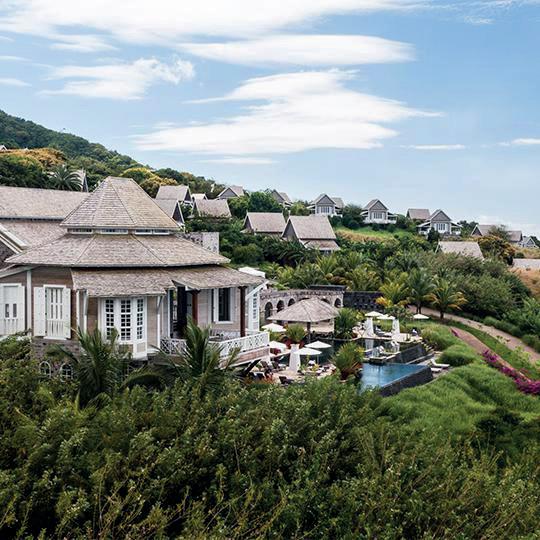
St. Kitts’ unspoiled rainforests, rich farmland and tranquil beaches seem tailor-made for the unique vision of this West Indian farm to table resort found on Kittitian Hill. To start with, the island of St Kitts is carefully managed to protect the landscape and a quarter of the land is set aside as a national park. As a working organic farm, Belle Mont is committed to preserving and celebrating the natural beauty that surrounds the resort. Through the owners’ dedication to local, sustainable living and partnering with like-minded farmers, artisans and specialist suppliers, they have created a community in harmony with the beauty of St. Kitts.
Found where the Caribbean Sea’s crystal waters meet the fresh Grenada saltwater breeze, this Relais & Chateau property is everything you’d expect from a sublime, contemporary beachfront hotel. At its heart is the Garbutt family and their gracious island hospitality, while recently two new collections of treatments have been unveiled at The Spa at Calabash – ‘Zero Miles Spa’ and ‘Cocoa Infused Treatments’ – which centre around the antioxidant-rich ingredients grown in Grenada. The hotel is part of Pack with a Purpose so please check out Calabash, Grenada Pack for a Purpose before you visit to see what supplies you can take to help support local projects.
























An intimate, family-run eco resort, Castara does things a little differently. Managed by a team of locals who have a stake in the business, the aim is to create a balance between the services on offer in a hotel with the freedom and independence of self-catering. Perched on a hillside above a friendly fishing village, Castara offers rustic luxury underpinned by excellent value, most notably at the relaxed restaurant where instead of fine-dining and white table cloths, you’ll find freshly prepared, creative food influenced by the flavours of the Caribbean.



Authentic experiences and sustainability are at the heart of Fort Young Hotel. First and foremost are its range of planned excursions and experiences that use locally-owned, managed and run transport and tourism services to provide a sustainable approach for all-inclusive travel. This not only gives guests a second-to-none holiday, it benefits the whole island.

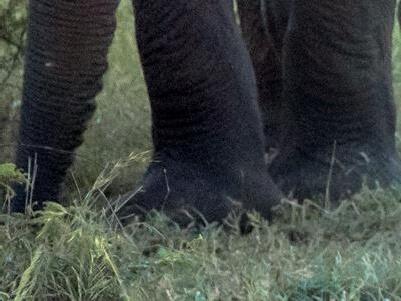
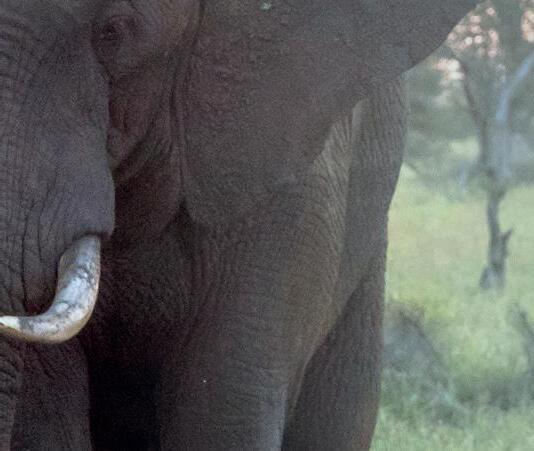


Located in Roseau, Dominica’s capital, Fort Young is in the main marina with the ferry port and market just a minute’s walk from its entrance. Refuel over traditional island dishes and relax at the waterfront Zemi Spa, or venture further afield for world-class diving, whale watching, and wildlife spotting on the Caribbean’s longest hiking trail, or take a dip in the island’s thermal spas, 365 rivers and dramatic waterfalls.
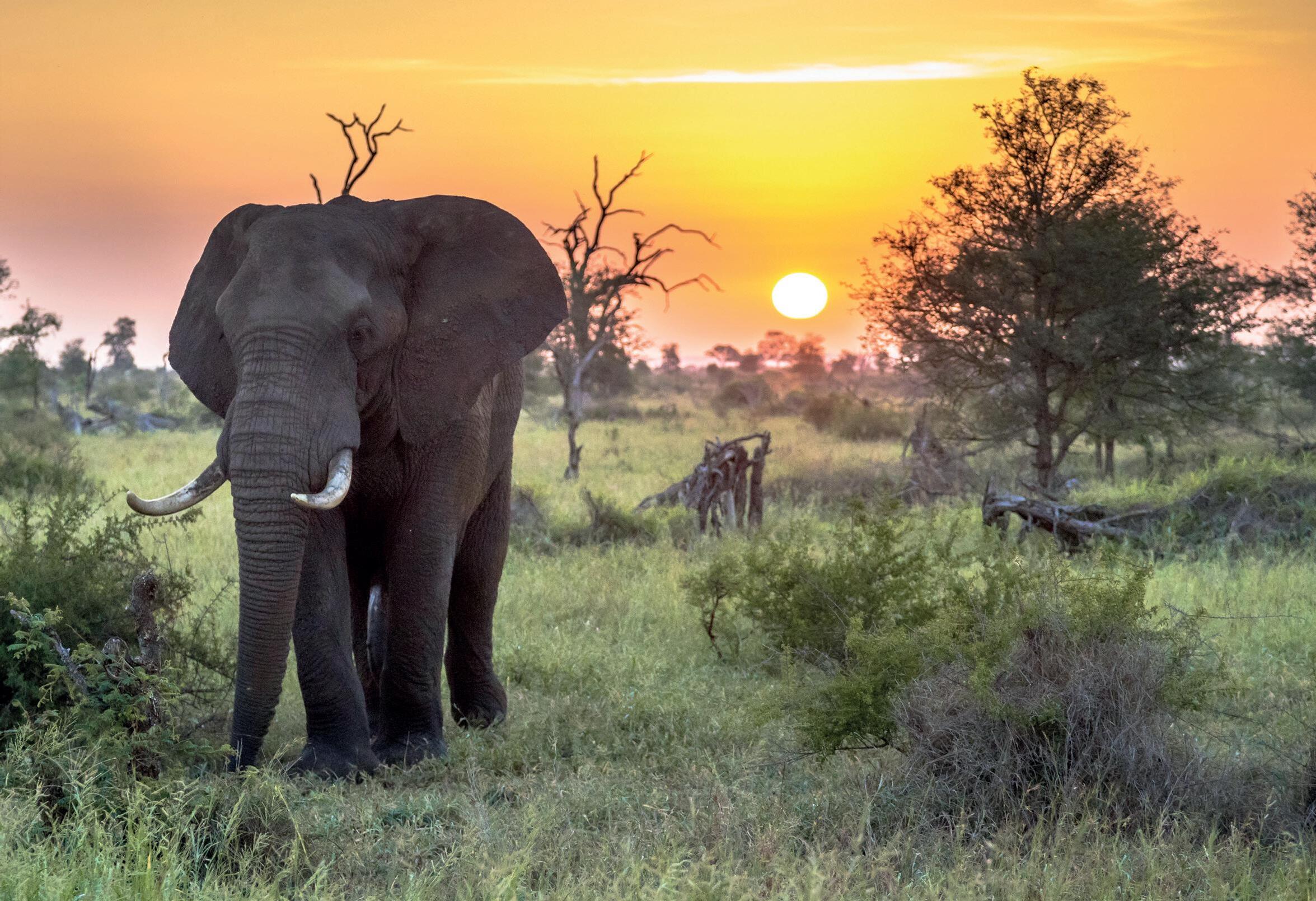

At Bucuti & Tara Beach Resort, the owners’ priorities are nature and beauty, and this has been evident since the hotel opened in 1987. Having made it onto the official list of CarbonNeutral® certified hotels in 2018, Bucuti is one of the greenest hotels in the world. There’s a dedicated sustainability concierge that’ll guide you to EV transportation, environmentally friendly activities and low impact meals during your visit, and there’s a great selection of vegan options at their restaurants. An adultsonly resort, Bucuti is a tranquil and wholesome haven for some R&R on the white powder sands of Eagle Beach.

A 10-bedroom boutique hotel located in Tent Bay, Eco Lifestyle + Lodge is in a quiet and unspoilt location overlooking the ocean. With a laid-back, rootsy east coast vibe this hotel is all about simple living and a deep respect for nature. Eco Lifestyle + Lodge is Green Globe Certified, and sustainable practices are apparent throughout the property: drinks are served with bamboo straws harvested in the garden, all water is solar heated and only organic cleaning products are used, while coral-safe sunscreens and surf wax are available in the ECO Shop. You’ll also find one of the island’s leading farm-to-table restaurants that’s developing a primarily plant-based and organic menu full of clean and wholesome dishes. Ingredients are sourced from local farms, the hotel’s own off-site organic garden and fresh seafood from nearby waters.
With a marine park larger than the island itself, St Eustatius is one of the region’s best diving destinations. Located five miles northwest of popular St. Kitts, the island has more protected historical sites underwater than anywhere else in the Caribbean, while on land the Quill volcano is one of the most predominant features of the island. To enjoy St Eustatius’ untouched nature both on land and at sea, check into one of Golden Rock’s 75 rooms, suites, villas and lodges and contribute to the positive impact the resort has on the lives it touches.

Architect owner Nick Troubetzkoy believes passionately in nature. So he created a hotel that makes the foliage and the flowers, the perfumes and the peaks, the sea and the bird song an integral part of the holiday experience. The estate covers 600 lush tropical acres bordering two soft sand beaches. Not only do you get a World Heritage Site anchored by the twin volcano peaks on land, the resort’s two crystal-clear bays are part of a designated marine reserve protecting miles of colourful coral reefs teeming with tropical fish. Due to its hillside setting this resort is only suitable for those with full mobility.

Settle into a pair of sun loungers on your own expanse of powdery white sand and take in the view of the gentle, crystal-clear sea lapping at the coastline as trade winds dance with palm trees. This is Bucuti & Tara Beach Resort, Aruba, the Caribbean’s first certified carbonneutral hotel. Nestled on Eagle Beach, affectionately known as one of the ‘Dream Beaches of the World’, a stay here is as nourishing for your relationship as it is the planet.

A honeymoon haven and ideal for romantic getaways, the resort is currently the seven-time winner of TripAdvisor’s best hotel for romance in the Caribbean, and regularly appears in its top 10 worldwide. The team at Bucuti & Tara relish helping every couple create treasured memories and new traditions; each couple is provided with a romance concierge who delights in ensuring their stay is as customised as they are as partners.
Every facet of the resort’s laidback
luxury experience focuses on the duo. From personalised wellness sessions led by Aruba’s top instructors and coupled plush sun loungers spaced from others to beachfront movies under the stars, wildlife and nature excursions, and even volunteering in sustainability efforts together, Bucuti & Tara is heralded for perfecting the romantic holiday.

Couples seeking a wellness holiday will find an all-encompassing, highly personalised experience here. Led by certified wellness professionals onsite and offsite, guests are matched with Aruba’s highest qualified instructors and nutrition, fitness, mental wellness and mindfulness are the cornerstones. When it’s time to relax and rejuvenate, the resort’s Purun Day Spa sources treatment ingredients from the island’s aloe. For the ultimate experience, opt for a soothing couples massage along the beach.
Led by a Michelin-trained chef, couples can delight in one of the Caribbean’s highest awarded dining experiences at Elements restaurant. The spectacular oceanfront setting, a front row to Aruba’s prismatic sunsets, offers globally-inspired food highlighted with natural, organic ingredients in European-style portions that are wellbalanced for healthier living.
From sustainable seafood to natural meats and locally grown produce, the menu is sourced with care and includes recipes from generations of the staff’s island and Caribbean families. With plenty of privacy and laidback luxury, couples can tune into one another and easily embody Bucuti & Tara’s signature style: Love, Peace & Happiness... Naturally.

It is not very often that I start my morning with an early sea dip in near freezing conditions, but there again I wasn’t raised in Bergen, Norway.
Nordnes Sjøbad, a seawater pool in the city, is packed with foolhardy bathers as we arrive on the first morning of our wintry trip through Norway. The land temperature is hovering around 40C, but the sea is a balmy 70C as I strut towards the steps leading to the bay, only a pair of bathing shorts to protect me. I descend the steps, dip my feet and immediately rush back to the sanctuary of the heated saltwater swimming pool. Thermometers in Norway clearly use a different scale to the ones I am used to.
Having failed my induction to Nordic life in winter, I take the Fløibanen Funicular up Mount Fløyen. After a short walk in the Troll Forest (where sadly we didn’t spot any real trolls), we headed off to a hut for lunch. While waiting for our lunch – a hearty and tasty vegan
soup – to cook we have a quick look at one of the most unusual places to stay in Bergen. From one of the trees the Cone hangs like a giant beehive, which you can hire for the night and sleeps two adults and two small children.

It is believed that Bergen was founded by King Olav Kyrre in 1070. Initially called Bjørgvin, or the ‘green meadow among the mountains’, its favourable location made Bergen the centre of trade between northern Norway and the rest of the world.
The old part of town – that which survived a succession of fires – is based around the harbour in the UNESCO World Heritage Site, Bryggen. In recent years Bergen’s gastronomy has received much international acclaim and much of its focus is on sustainable fish stocks.
This we experience when we dine at Fish Me restaurant at the Bergen Fish Market, located in the harbour, where I had some excellent turbot. There is also a revival of local fish dishes like plukkfisk and pressed
cod, as well as two food festivals – one in September, and a Seafood Festival in February.

The following day, we meet again at the Bergen Fish Market to go on a Bergen food tour with Anne, from Bergen Base Camp. Here she introduces us to Bergen fast food – a fish cake that looks and feels like processed tofu but tastes unexpectedly brilliant.
Anne’s tour is a combination of food and history. She takes us back to Bryggen where she explains the success of the city was based on stockfish – fish that was dried in north Norway and then transported around the world from Bergen. A great source of protein, it is an acquired taste, but proved vital for sailors spending months at sea away from land. charitable.travel/travel-beginsat-40

It’s not the most famous stretch of coastline in the UK, but local resident and Girl About Ambassador Maria Davison believes the Durham Heritage Coast should be, and shares her favourite spots

Visit the Durham Heritage Coast and you’ll find rugged cliffs, dramatic landscapes and meadows bursting with wildlife and flora. And below those imposing headlands are tranquil coves, each with their own unique features and attractions.
Stretching from Sunderland to Hartlepool, a walk here leads to an adventure through industry and into nature. Discover the remnants of the coast’s industrial history and see its breathtaking transformation – and I bet by the time you leave you’ll also think it’s one of the finest stretches of coast in the UK.

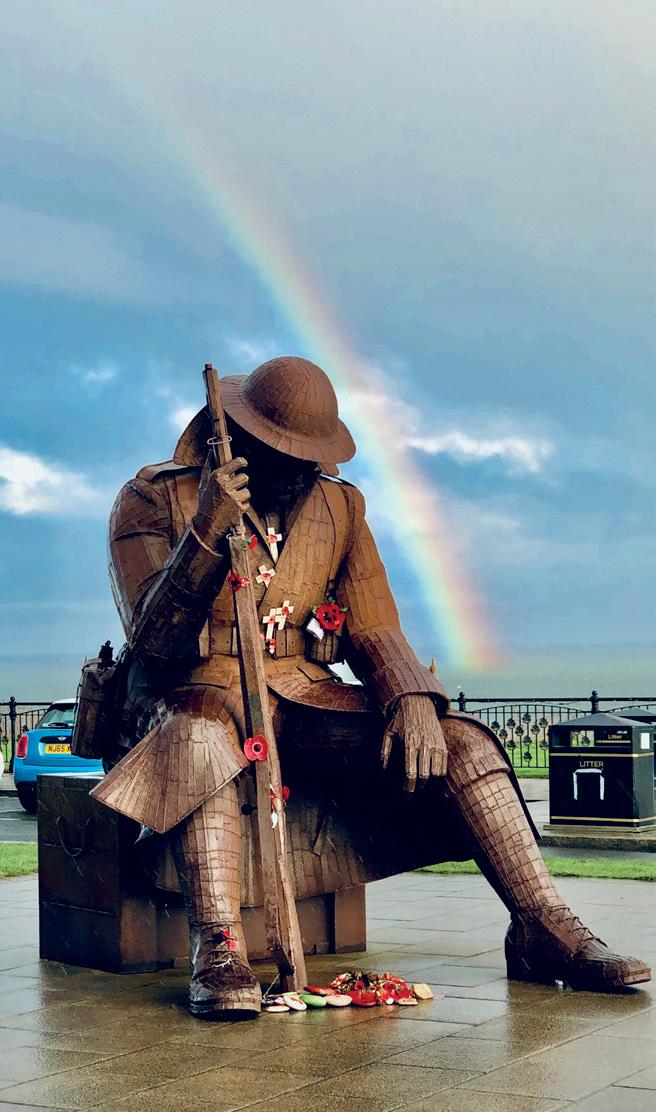
No visit to the Heritage Coast is complete without a stroll along Seaham Beach, known locally as Seaglass. The stretch of beach that lies beneath the quaint harbour town of Seaham is world-famous for its abundance of shimmering sea glass. In its industrial past the local bottleworks dumped tonnes of waste glass into the North Sea and many years later it is washed up as treasure with each tide.
Make sure you visit at low tide to find your own little gems to take home to treasure, while in Seaham’s
shops you’ll find both jewellery and art made from seaglass.

This stretch of the coast just south of Seaham has been affected by constant change over the years. It’s famous for its part in the opening scenes of the classic 1992 movie Alien 3 and once you visit, you’ll understand why. Blast Beach is a completely unique beach due to its orangey appearance and red pools dotted beneath the cliffs. In its past, colliery and chemical waste was dumped here damaging wildlife, plants and meadows. It was, at that time, known to be one of the worst polluted coastlines in the world. After years of restoration and regeneration work, it is now a stunning beach with unusual geology and a unique panorama – it has unusual rock formations, a prehistoric feel and a red Mars-like seascape.
Hawthorn Hive beach is something of a hidden treasure along the Heritage Coastline. As it’s off the beaten track, you can expect it to be quiet and unspoilt most of the time. This is perhaps one of the most peaceful spots
on the Durham Heritage Coast, where you can enjoy a quiet walk through protected woodland as you make your way down to Hawthorn Hive Beach, quickly travelling from countryside to coast within a short space of time. On your approach to the cliffs, you will be rewarded with the sight of the most beautiful pebble art on the beach below. The art is created by locals and ranges from small pictures to huge scapes and occasionally marriage proposals. Once you reach the beach make sure you create some of your own art or continue a current piece and leave your mark behind on this secluded beach.
Girl About Travel is a unique online platform created by travel industry experts – a journalist and a tourism marketing and comms specialist –and provides content for women who want to make amazing memories with their loved ones, either in the UK or overseas. A trusted partner of Charitable Travel, Girl About Travel’s content is created by a network of female writers, AKA the Girl About Blog Squad – the official Girl Abouts in their cities and counties. Follow them on charitable.travel/girl-Instagram. about

Seaham is a lively harbour town with plenty to offer locals and visitors alike. Highlights include a great selection of quirky cafes, ice cream parlours and independent shops. For a great spot to eat with stunning views try The Lookout in the marina. It serves up a great selection of food and drinks, perfect for a brunch or lunch time stop. Alternatively, try the North Beach coffee bar that sits at the gateway to the Durham Heritage coast. It has a modern, fresh interior and serves home-baked cakes and warming drinks – ideal for setting you up for a day along the coast.
Base yourself at the Seaton Lane Inn, a relaxed hotel with boutique style rooms (some for families) and a delicious menu. It’s only a five-minute drive from both Seaham and the coast.

Make sure you include a visit to ‘Tommy’, a 9ft 5in statue of a World War I soldier and one of the best-loved sculptures in the North East. Built by local artist Ray Lonsdale in 2014, he’s the guardian of the Heritage Coast and sits on the seafront at Seaham.
On your approach to the cliffs, you will be rewarded with the sight of the most beautiful pebble art on the beach
Seven nights from £1,499pp Find out more and book at charitable.travel/hyattinclusive-collection


Among acres of tropical gardens and jungle, Dreams Tulum Resort & Spa is located just minutes from the ancient Mayan ruins and the trendy and bohemian town of Tulum. Dreams Tulum is a AAA Four Diamond award-winning resort, with all the benefits of UnlimitedLuxury® - where everything is included. Dreams Tulum’s magnificent Mexican colonial architecture blends tastefully with upscale contemporary design where every room offers a private and furnished terrace or balcony, marble bathroom, daily refreshed mini-bar and room service. Dreams Tulum also offers a secluded adults-only section and swim out suites for direct access to a pool. The resort is not only beautiful on the outside, but also within – as the founders of the Tulum Foundation, this eco-friendly resort promotes education, culture and conservation in the local community.

Unlimited-Luxury® facilities
Nine restaurants, with six à la carte options
24-hour dining options and room service
Seven bars and lounges
466 rooms each offering private furnished terrace or balcony
Two swimming pools
Explorer’s Club for Kids
Non-motorised water sports
Fitness centre
Dreams Spa by Pevonia®
Upgrade to Preferred Club
Private Preferred Club lounge
Personalised check-in and checkout with concierge service
Preferred status and amenities
Dedicated beach area
Upgraded mini-bar service and bath amenities
Daily afternoon hot and cold hors d’oeuvres
Access to two additional swim out pools*
*Only available for adults in Preferred Club Swim Out room categories
What is the Tulum Foundation?
CR: The Tulum Foundation was launched by the owners of Dreams Tulum Resort & Spa in 2006 with the goal of supporting local children and protecting the Mayan culture throughout the local community. The Tulum Foundation provides a well-rounded array of services including scholarships for students to attend collegiate-level courses and helps support the preservation of Tulum’s surrounding ecosystem. Evolving over time, the Foundation also provides health assistance, such as basic medical and dental care, and also created a mobile library to promote literary arts throughout the community.
Who created the Tulum Foundation?
CR: Seeing a need to support the culture of the Mayan people throughout Tulum during the spike in tourism, the owner of Dreams Tulum Resort & Spa, Maria Rosa Sandretto, established the Foundation in 2006. The nonprofit was developed to not only preserve the culture of the Mayan people, but also promote and cultivate the skillset of colleagues and local members of the community while promoting art and culture throughout the destination. The work that the Foundation has done under Maria’s guidance has positively impacted all facets of the community. The resort is based on the edge of Tulum National Park, so the social and environmental responsibility is something the resort and the Foundation take seriously.
Alongside the good work of the Tulum Foundation, what other sustainable measures does Dreams Tulum have in place?
CR: Dreams Tulum Resort & Spa, part of Hyatt’s
Inclusive Collection, is only one of two resorts in Quintana Roo to be recognised as a green hotel. The resort takes this responsibility seriously, and this prestigious recognition is a direct reflection of the efforts the resort has made to prioritise the community and the environment within its operating model.
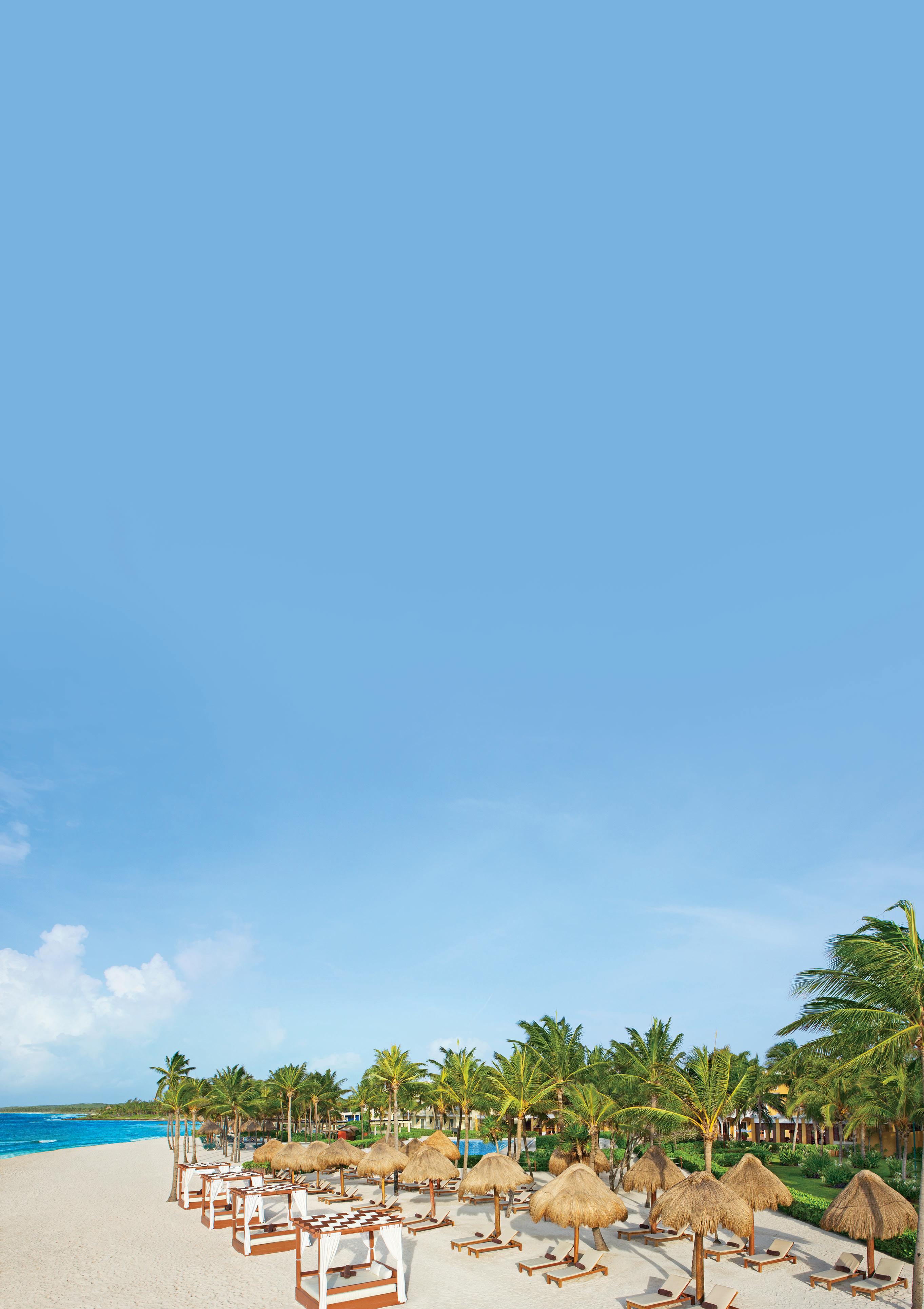
What does this mean for guests staying at the Dreams Tulum Resort?
CR: Reflective of Hyatt’s World of Care philosophy, guests of Dreams Tulum Resort & Spa can book with confidence knowing that every aspect of their stay has been well thought out. From the front desk to housekeeping to the food & beverage department, everyone is doing all they can to not only make sure that the guest experience is a memorable one but minimizing the environmental impact as well. In addition to the efforts of Dreams Tulum Resort & Spa colleagues, guests can also take part in Foundation efforts. For example, guests have an opportunity to visit Foundation-supported schools, which provides an opportunity for guests to give back to the local community and has become increasingly popular in recent years.
How is the Tulum Foundation funded?
CR: There are several ways colleagues, guests and members of the community can get involved. Guests can donate to the Foundation by visiting select areas throughout the resort or through the Foundation’s website, fundaciontulum.org. For those looking to bring supplies during an upcoming stay, guests can reach out to the resort directly and obtain a list of current needs, in advance of travel.

It’s the only multi-retailer gift card that can be spent exclusively in charity shops. It’s currently accepted in Marie Curie, Shelter, The Children’s Society, YMCA, Crisis, Traid and lots of hospice shops, and we’re on target to increase that to nearly 2,000 shops across the country in the next few months.
There are two sides to the card – first is the consumer side, with people buying the gift cards (they’re available in supermarkets and lots of online retailers including Amazon) as an alternative to fast-fashion gift cards. We’re the sustainable option, and I think charity shops are really coming into their own now with sustainable fashion.
Then there’s the support sector side, whereby councils, other charities, and other support organisations can buy the cards and distribute them to their service users. For example, we work with Warrington Borough Council who use it as part of their local welfare assistance. You can get so many essentials in a charity
shop – from clothing to furniture, homewares and white goods – that it doesn’t make sense to buy new when they already exist, plus you can support a charity at the same time.

We always say it’s two good causes for the price of one – the card helps somebody in need, and it also helps a charity to support the community and continue their amazing work. As a social enterprise, most of our profits go to funding free cards for support agencies.
What’s really nice about the two sides of the gift card is that the consumer side helps offset any potential stigma that people may feel if they’re receiving it as part of a support package. When you go into a charity shop to spend it there’s nothing to identify you as being in need.
My marriage had broken down in 2019 and I ended up fleeing with my four kids and taking nothing with us. Initially we needed clothing,

but then when we moved into a house I needed everything, from beds for the kids to cutlery and toys. I remember needing a potato peeler and it really hit me, you just don’t realise how much stuff you accumulate in the home and when you have to replace it all, there’s so much. We were in a very privileged position where friends, family and colleagues were able to help us, but a couple of things really struck me.
The first is how important choice is. Of course, I was grateful to be given stuff, but I didn’t realise how much it can impact your mental health and your self-esteem when that autonomy is taken away.
Secondly was how humiliating it felt that everyone knew my life was in crisis. Yes the help was amazing, but I was also aware that not everyone is in such a fortunate position as to be able to access help. What happens to these people? I previously worked as a teacher in an inner city school so I’d seen the impact on children whose families were struggling, and after I had to leave my job I was on benefits
CharityShop Gift
Card, shares the inspiration for the multi-retail gift card that rethinks how both consumers and support agencies can use charity shopsSARAH COX
and going to food banks. so I’ve experienced all that stigma.
I kept thinking there must be a way that people in a similar situation to me could go and shop for free in charity shops, because people donating to charity shops wouldn’t mind if donations went to people who had nothing, yet charity shops need that revenue to do their work. The Charity Shop Gift Card is the solution, with the vision that it’s nationwide and on no matter which high street, people could go into charity shops and be like any other consumer in there.
Running alongside that, and unbeknownst to each other, Lottie Bradley, a retail design manager for Save the Children was discussing with her dad, Richard, who works in retail payments, why there isn’t a gift card for charity shops. They started looking into it, and approached Richard’s former colleague Lee Fellows, who worked in the gift card market.
I reached out to the Charity Retail Association, who put me in touch with Richard, Lottie and

Lee. While they were coming from the consumer side, I brought the philanthropic side just at the time they were looking to make their offering more socially conscious, and the rest is history.
Buy the gift card for all your family and friends. It’s a nice way to introduce people to charity shopping, and I think it can be really eye-opening for people to see what’s in the charity shops now. We encourage people to take a slower look at fashion and change the perspective of charity shops; some of them now are really lovely boutiques.
If you’re reading this and work for a charity or other support agency that supports people financially, I’d encourage you to look at the card as an option. We distribute cards through food banks and refuges, and to refugees and asylum seekers. It’s a really nice way to give people funds as well as autonomy and choice.

WHAT WOULD YOU LIKE TO SEE CHANGE IN YOUR AREA?
What we’d really love to see is second hand becoming the first option for people, especially for councils and support agencies. There’s so much in circulation already and the amount that goes to landfill is scandalous, yet there are people who don’t have a washing machine or
Find out more about the Charity Shop Gift Card, where you can use it, and how you can help, by visiting thecharityshopgiftcard.co.uk

a coat for their child. How do you close that loop? With The Charity Shop Gift Card, so people can choose what they need, and make a more sustainable choice while doing so.
Awareness is probably the biggest, but we’re waiting for a few wellknown national charities to sign up and once they do, we’ll go bigger on our presence.
It’s an organisation with really strong ethical values. We’re not in it to make money, we’re a solution to a problem that affects lots of people, and we strongly believe that what we’re doing is going to benefit individuals, the environment and the communities the charity shops are in.

This year the focus is on growing the shop redemption network, and reinforcing the message that second hand isn’t second best. Our card both removes any stigma and pushes the sustainability message, so we want it to grow and grow.
Hammersley Homes provides support to vulnerable adults who live with enduring mental illnesses and struggle with living independently. Its Outreach Service offers friendship and help with daily challenges, and encourages social and community interaction to increase confidence and reduce the loneliness and isolation that is so often present in these vulnerable lives.

550,000

PEOPLE IN THE UK ARE REGISTERED AS LIVING WITH A SERIOUS MENTAL ILLNESS (SMI)
UNKNOWN number of people in prison with mental health issues – no one is counting

UNKNOWN number of homeless people living with mental illness – no one is counting
25% of adults experience a mental health crisis at some point in their life
27-MONTH WAIT FOR AN NHS AUTISM OR ADHD ASSESSMENT IN HAMPSHIRE
£35 BILLION
COST TO BUSINESS THROUGH LOST DAYS DUE TO MENTAL ILL-HEALTH
£327,062 Lottery Community Fund awarded to expand its Outreach Programme
48
The number of clients registered with Hammersley Homes to receive support through its Outreach Programme

15
The number of volunteers working on its Outreach Programme - always looking for more!

8M PEOPLE IN THE UK ARE SUPPORTED BY MENTAL HEALTH CHARITIES – THAT’S ONE IN EIGHT OF US
10,000
PEOPLE IN HAMPSHIRE ARE REGISTERED AS LIVING WITH A SERIOUS MENTAL ILLNESS (SMI)
£20,000 per annum is the cost of one Outreach pod which supports 16 clients
Book








Whether you’re longing for a beach break to build amazing memories with your family, a romantic escape with your loved one, or want to don your backpack and venture back into the great unknown, our team of travel experts can help you plan and book the holiday you deserve.



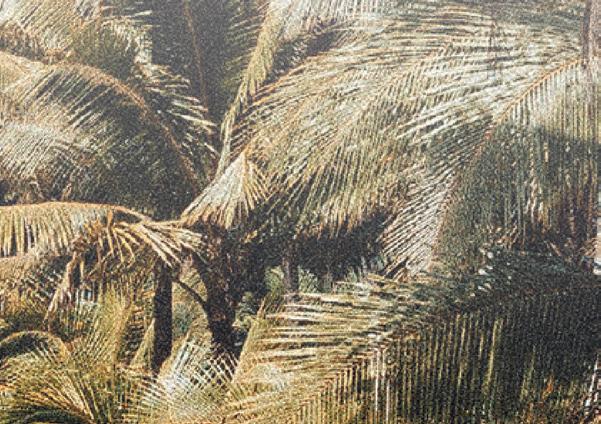


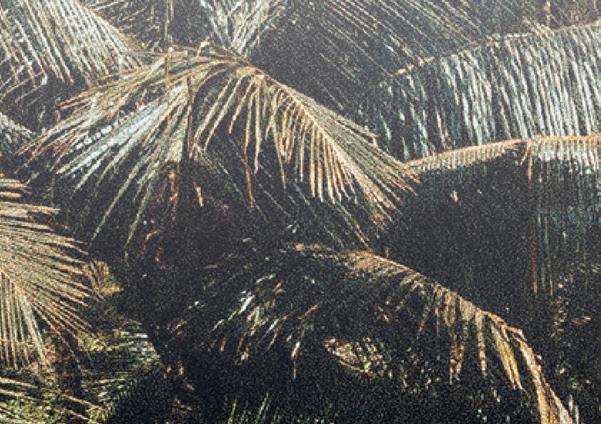



Plus, when you book with Charitable Travel you can donate 5% of your holiday cost to a charity of your choice… completely free!









